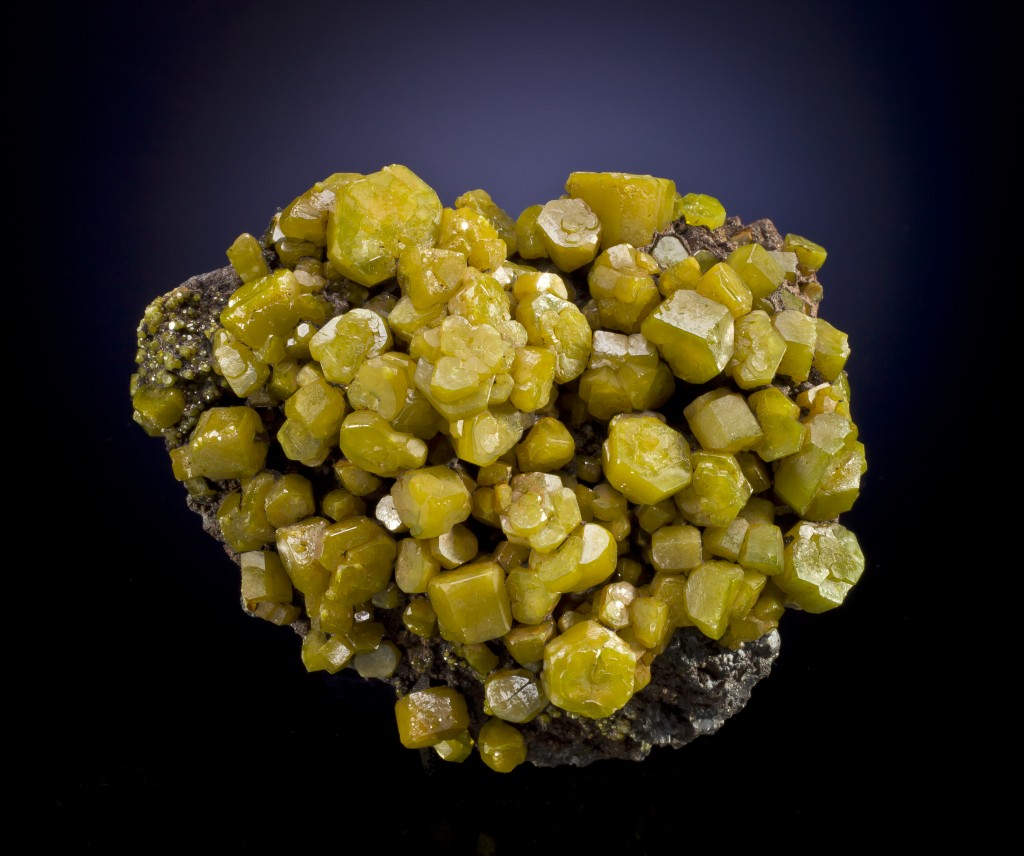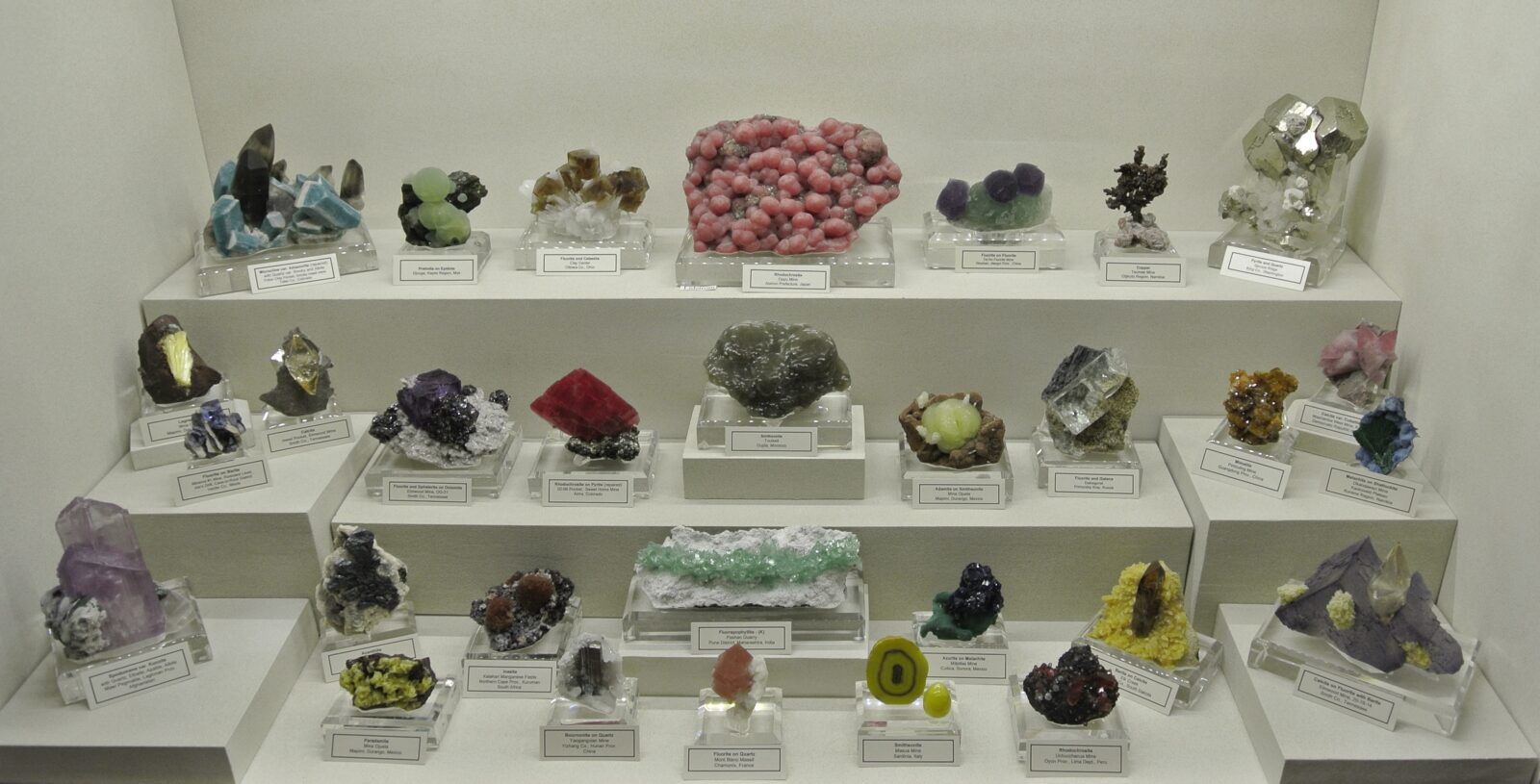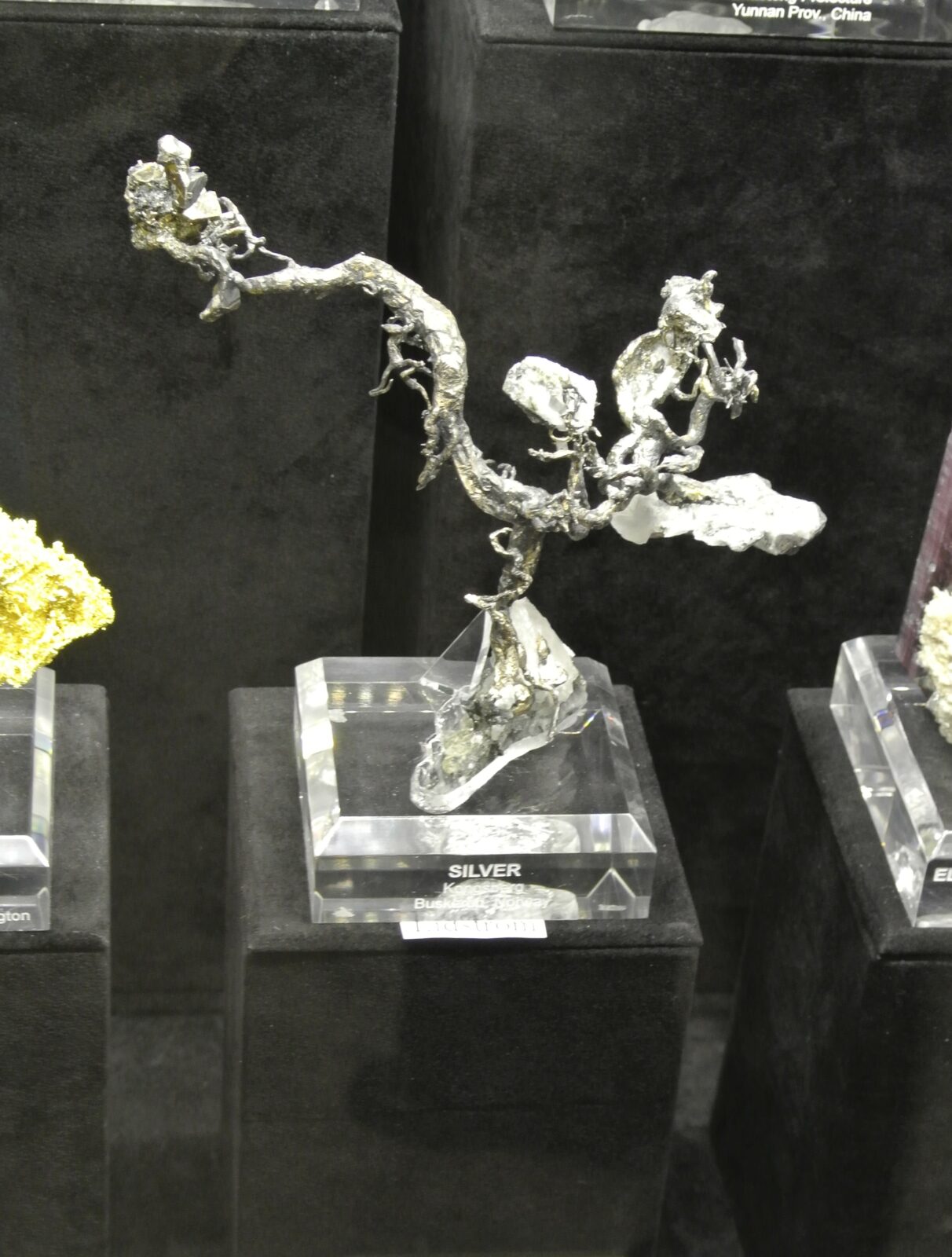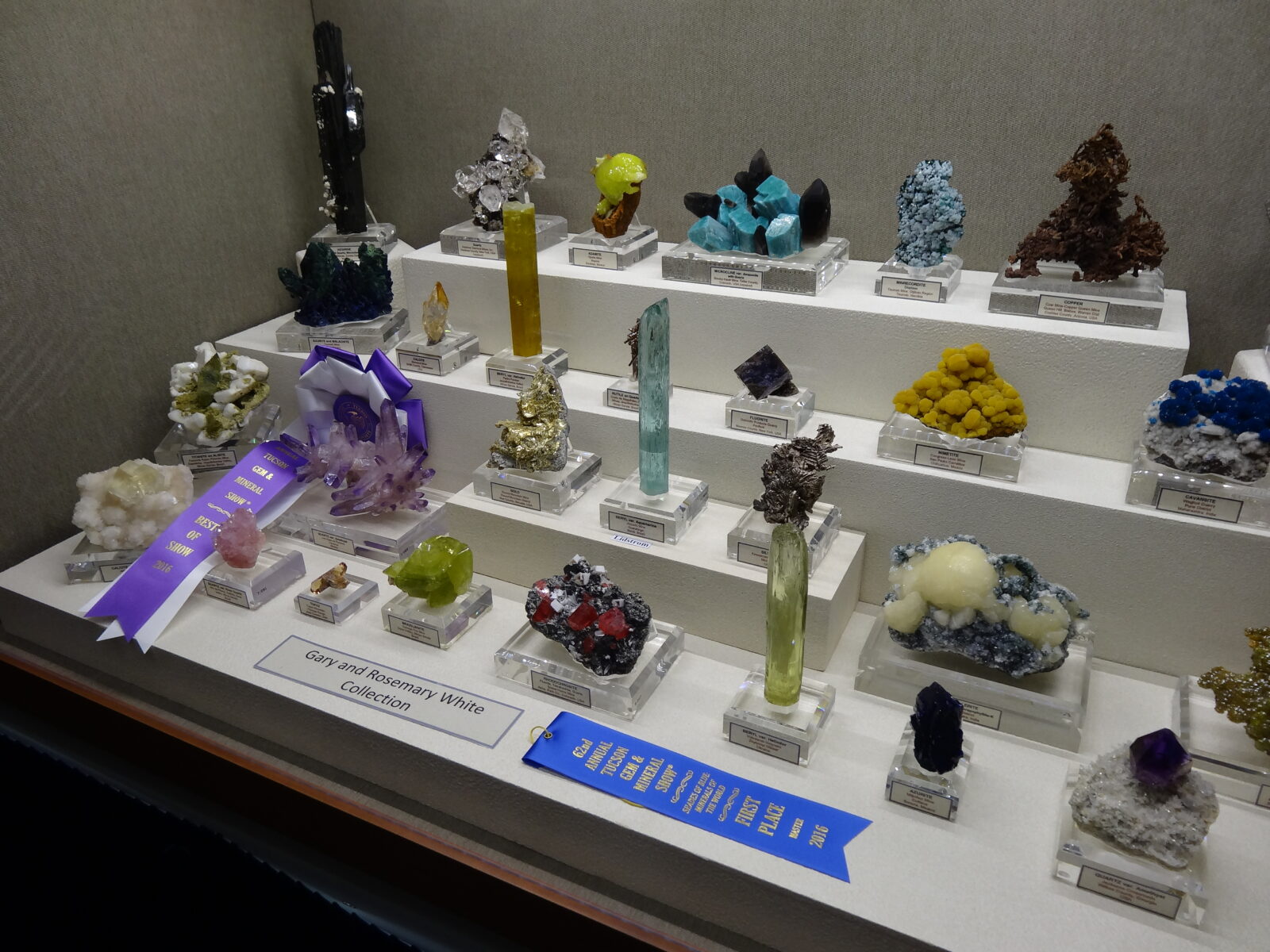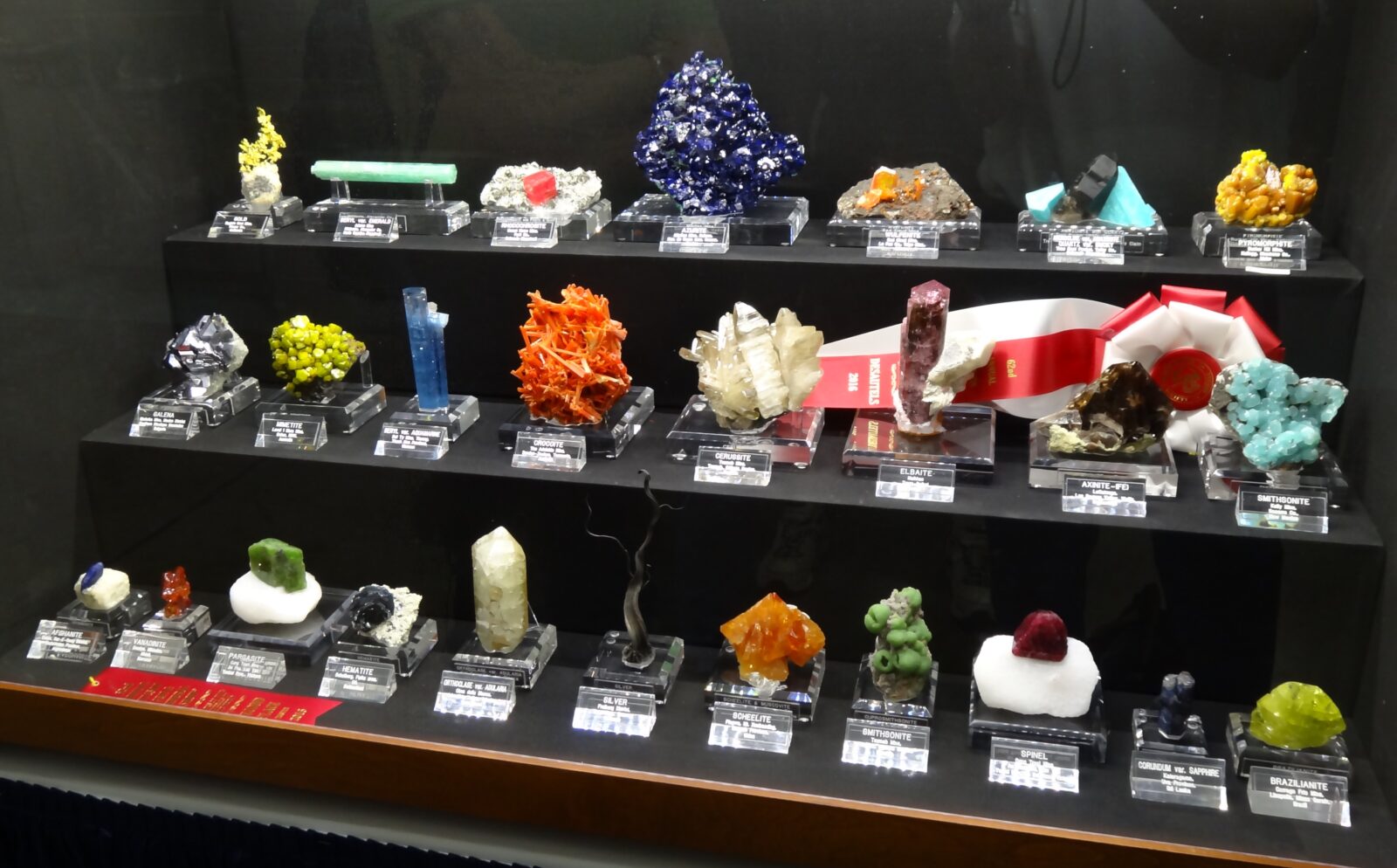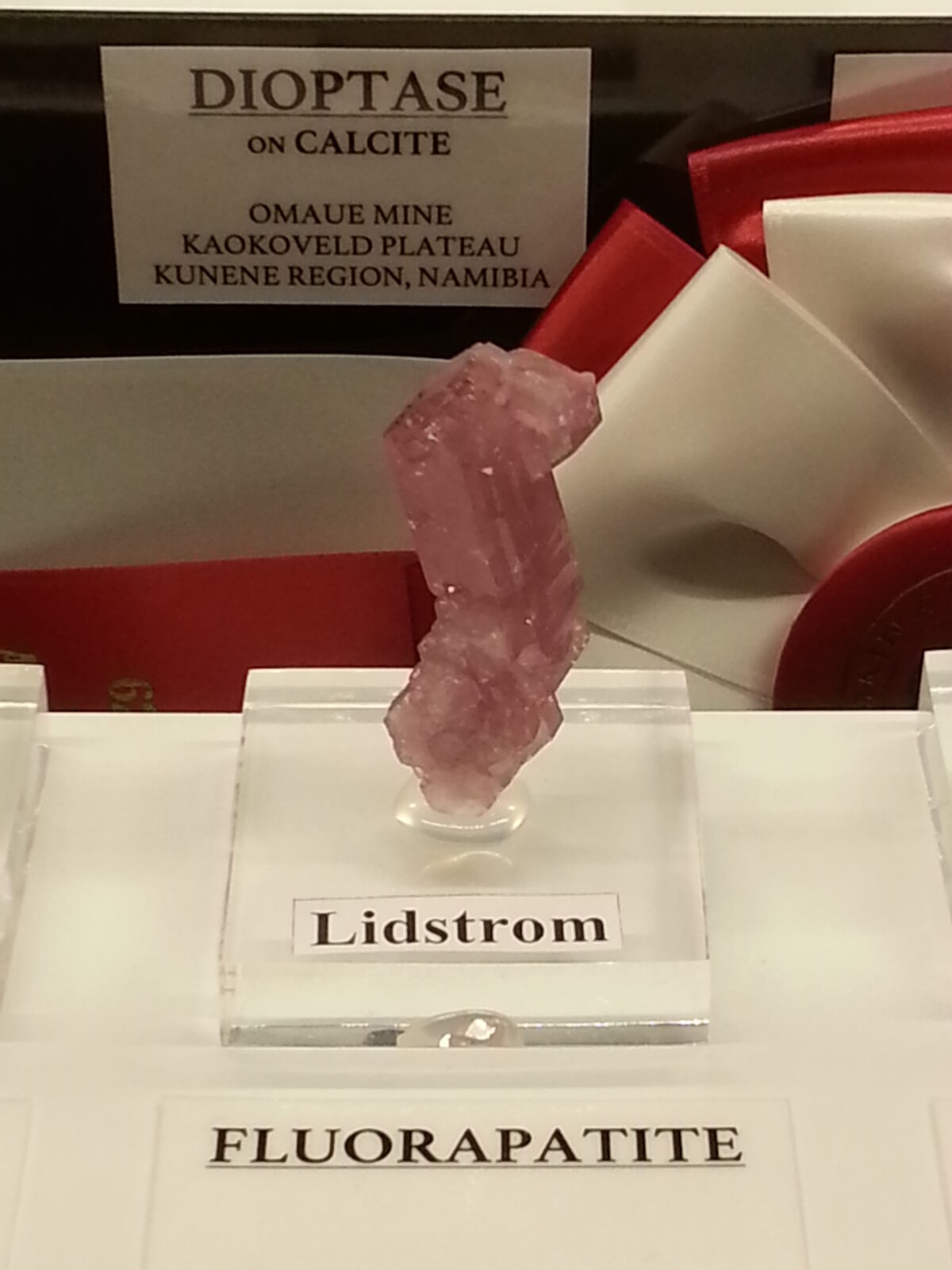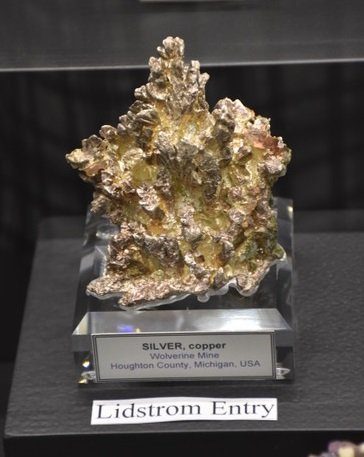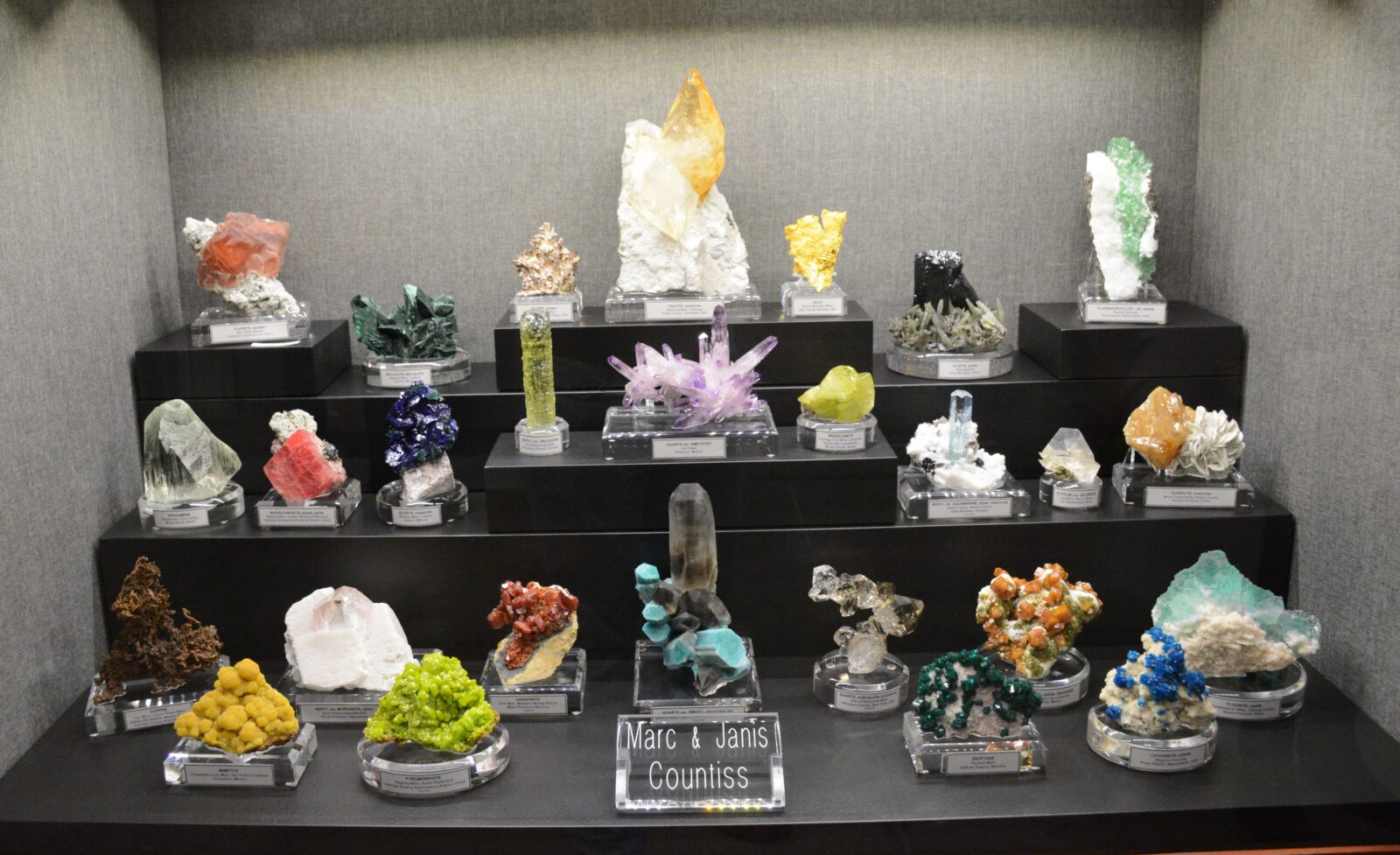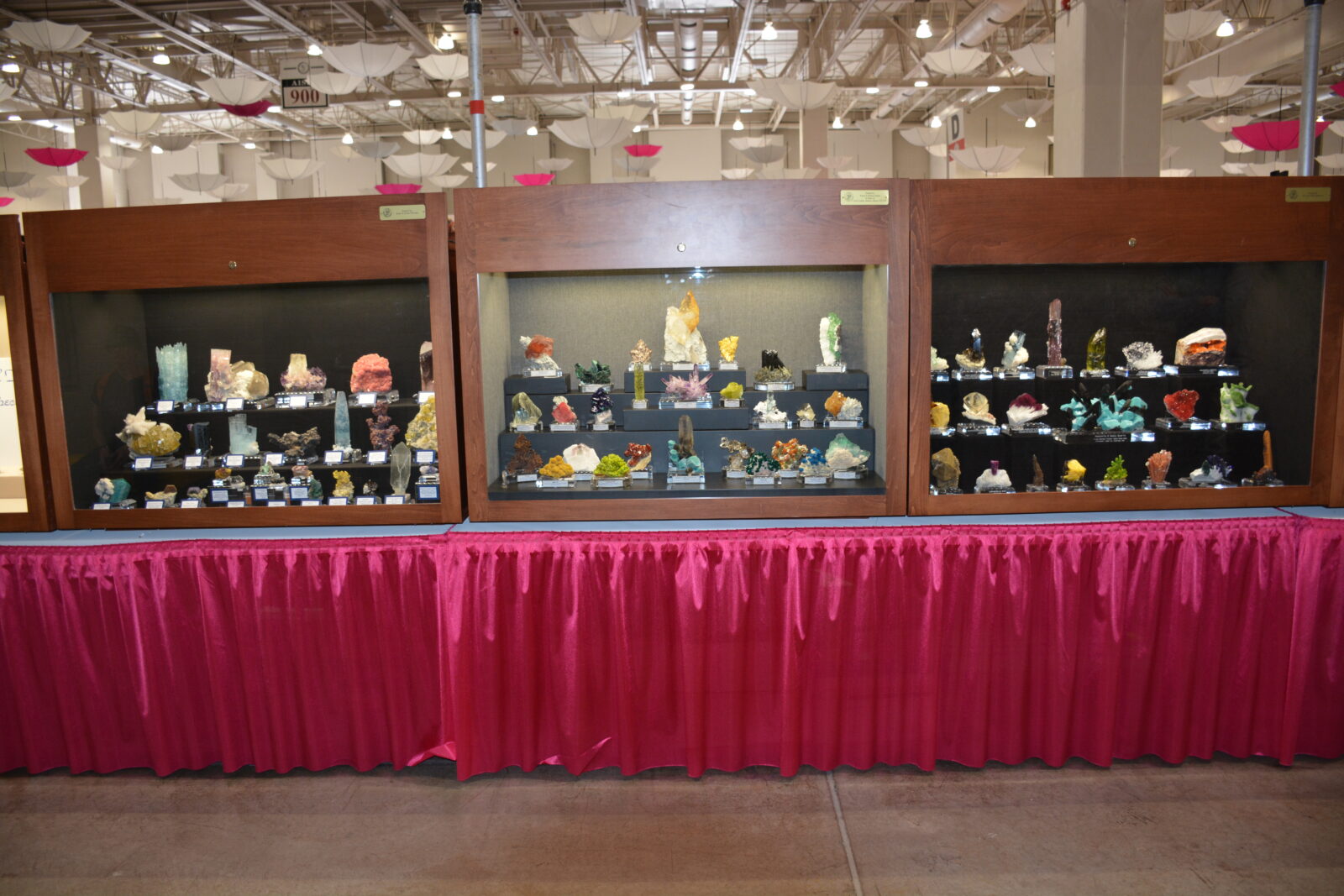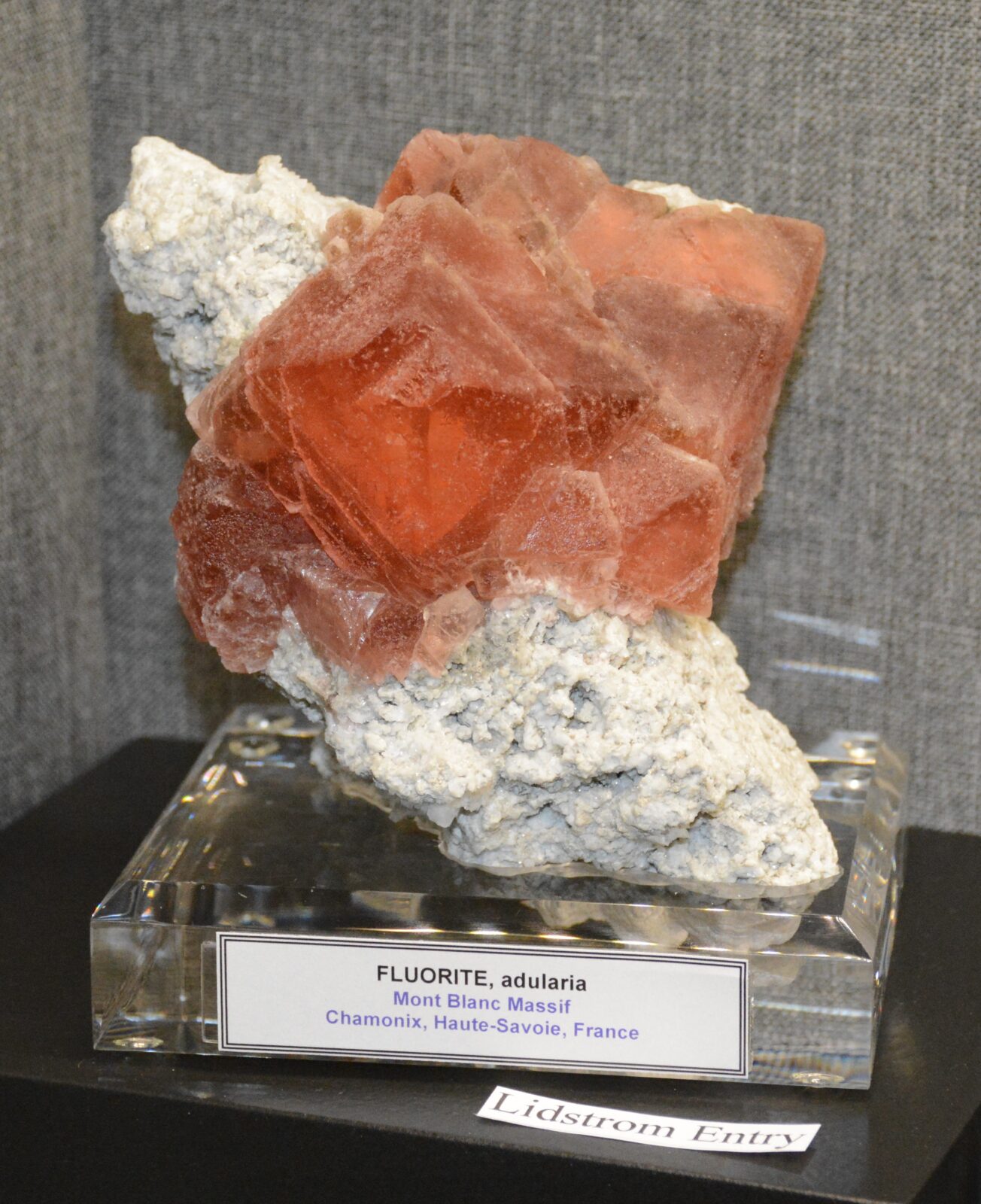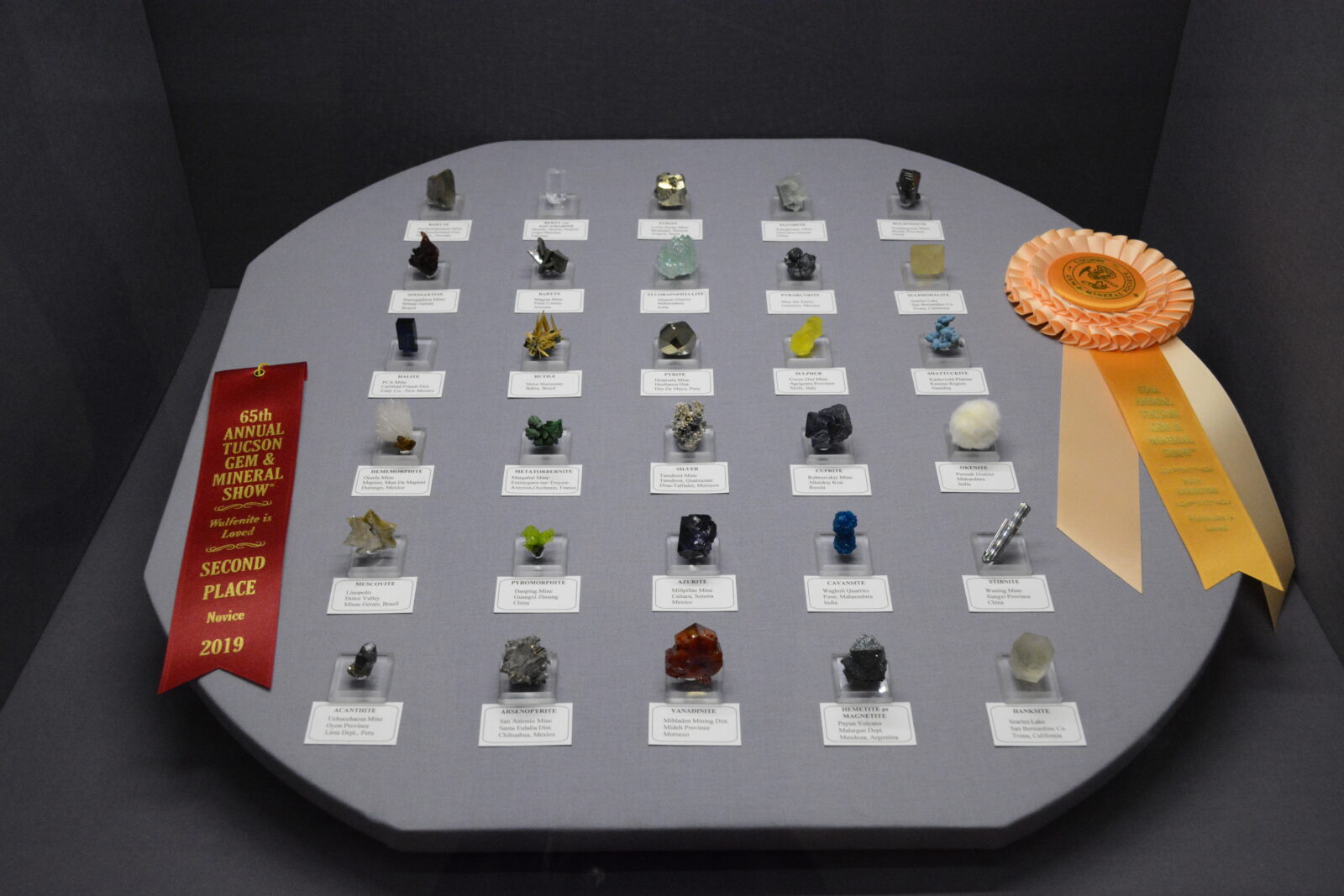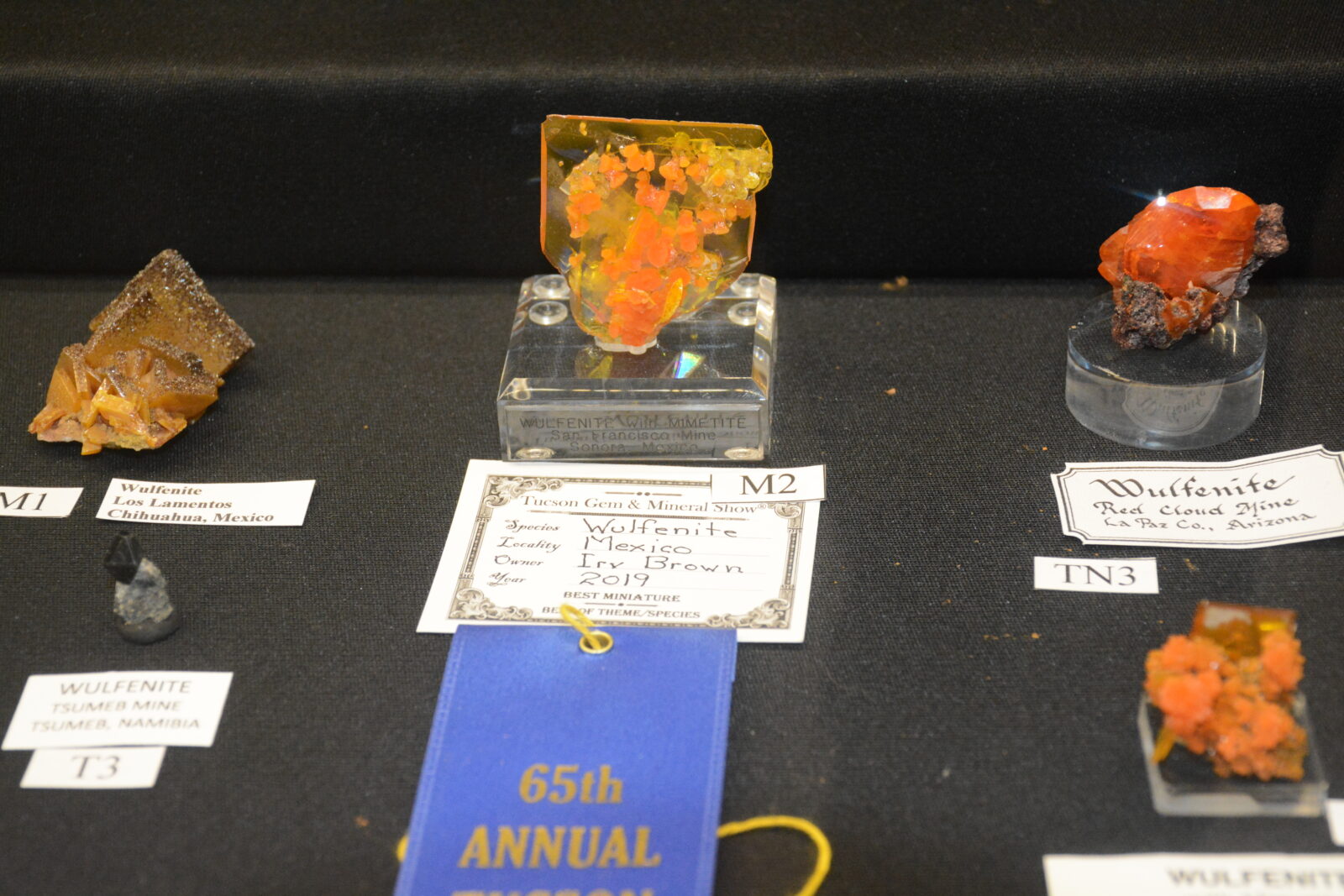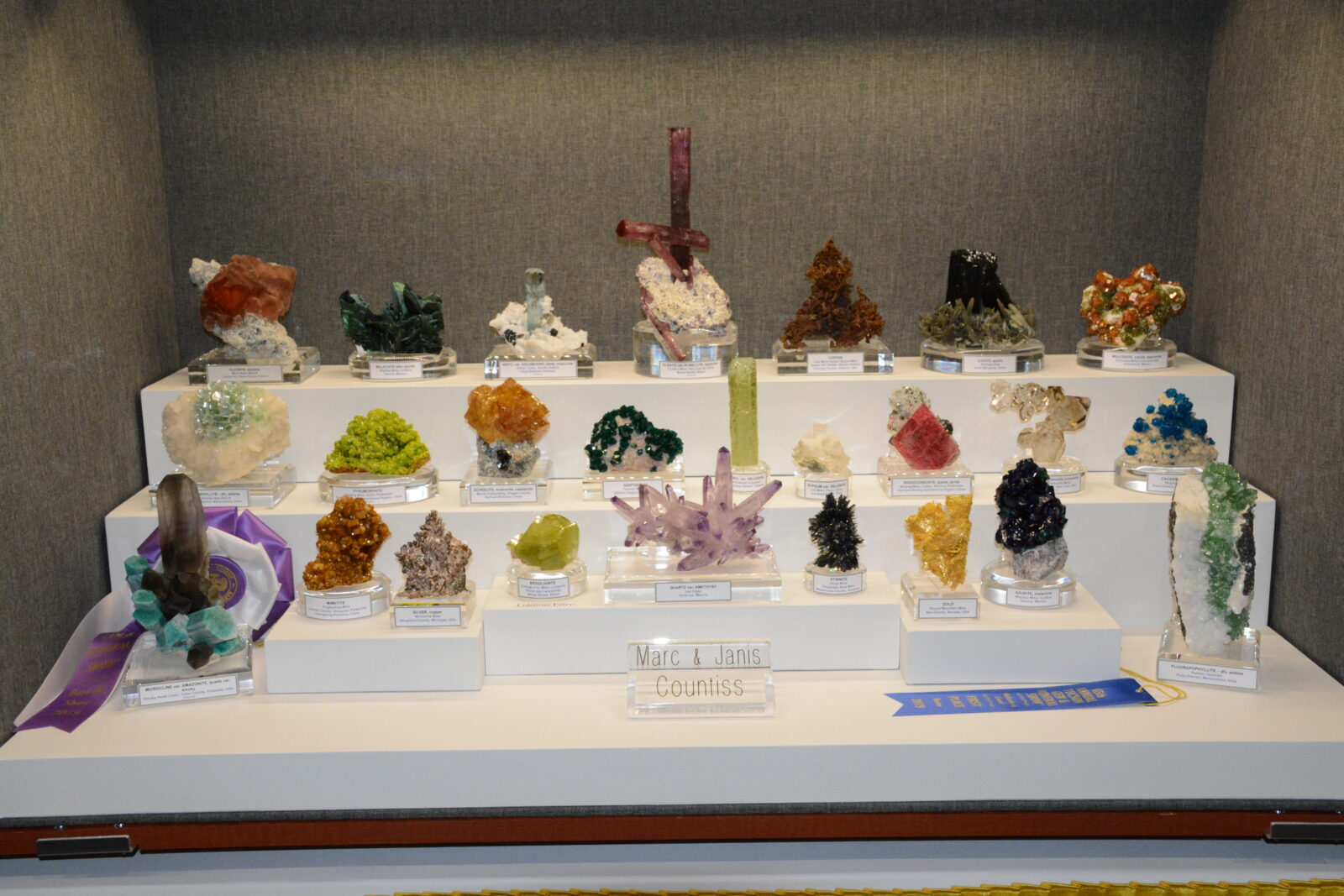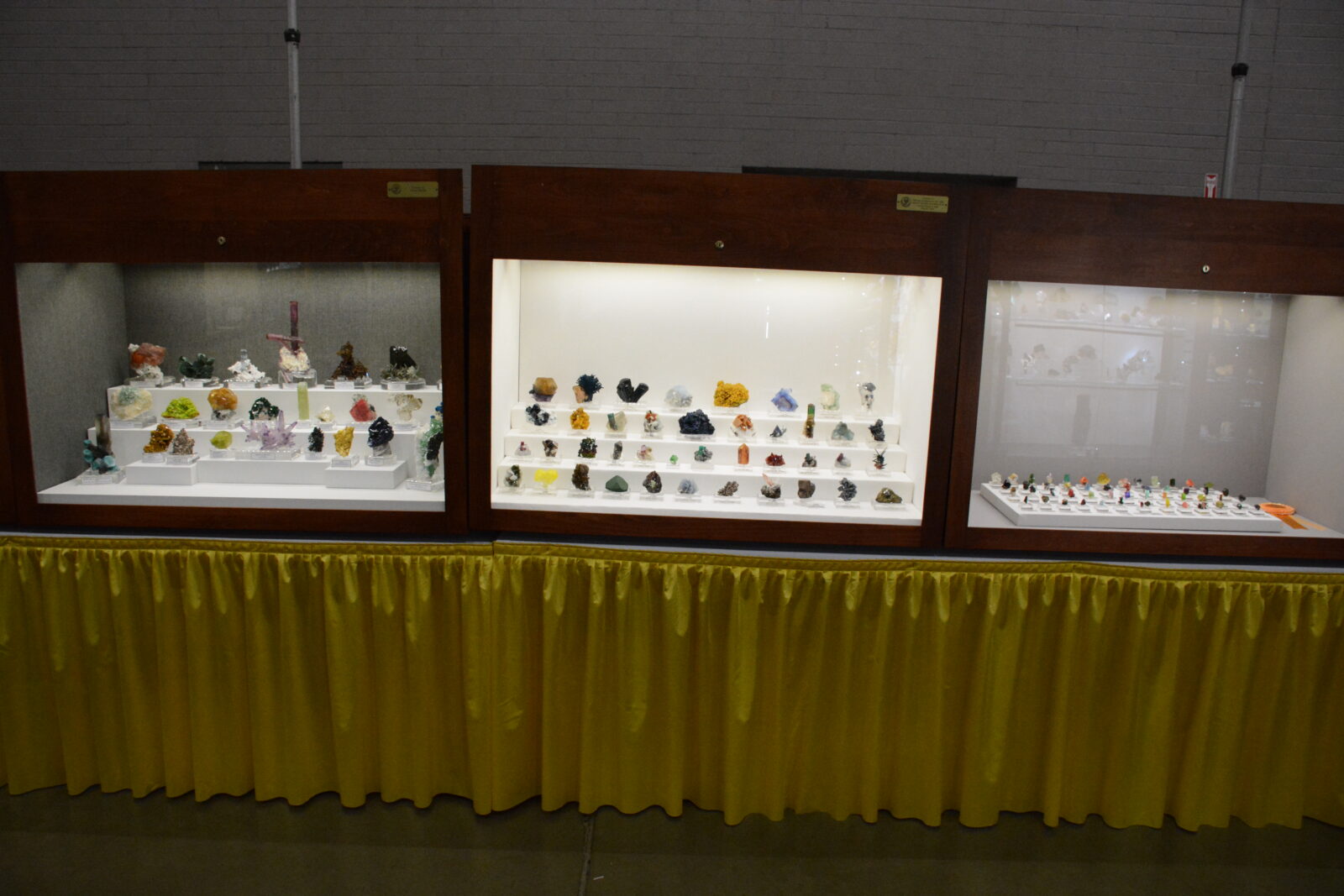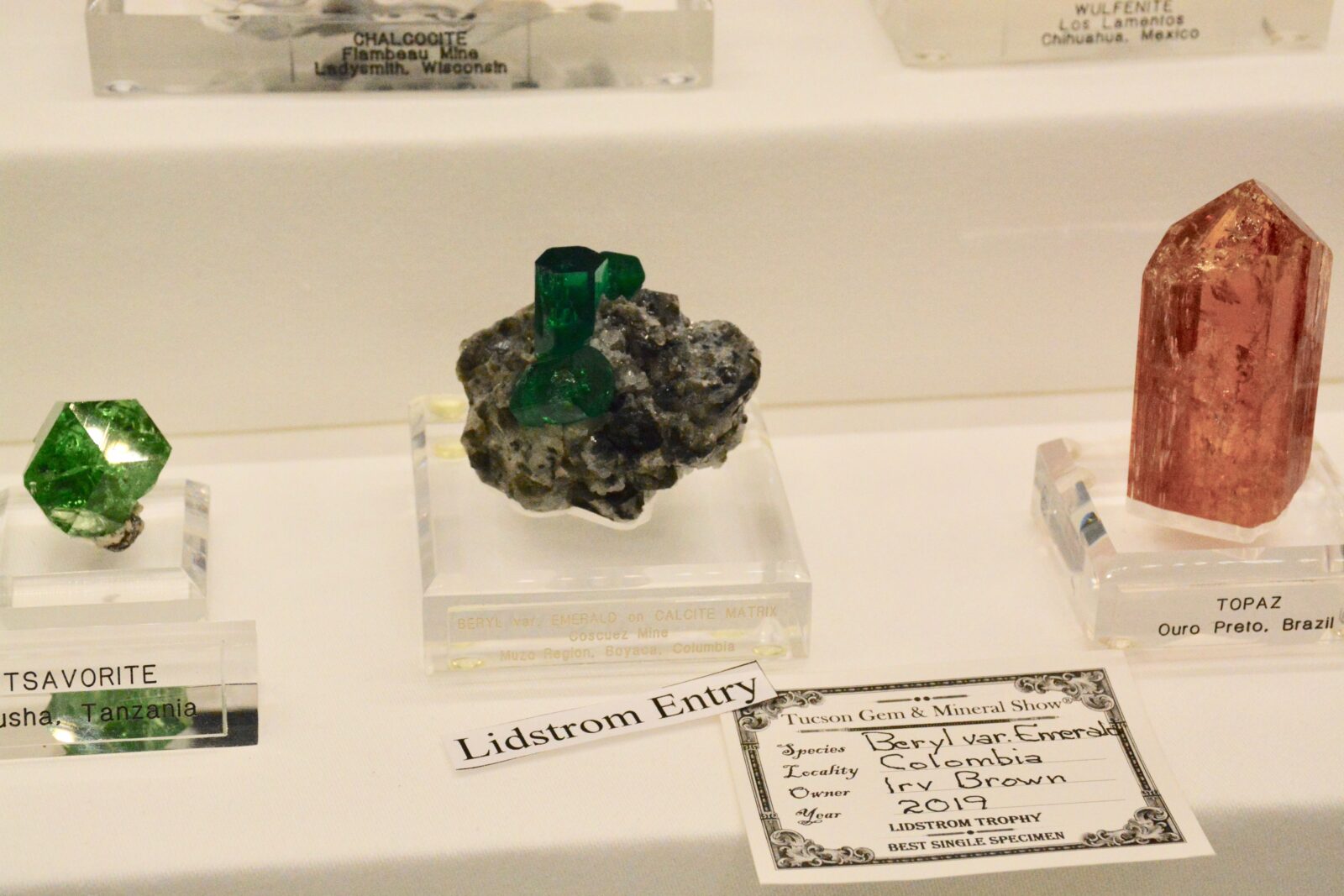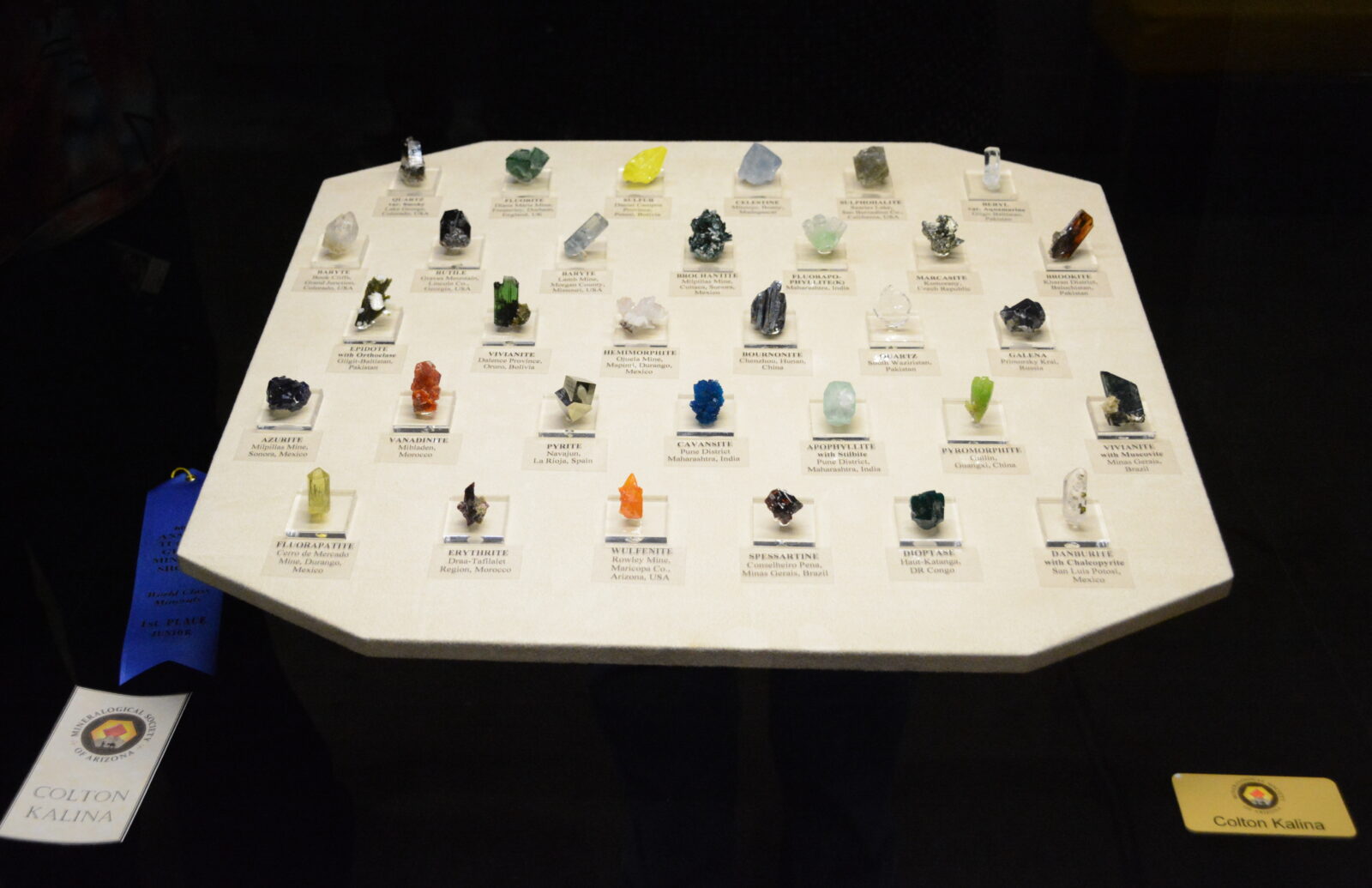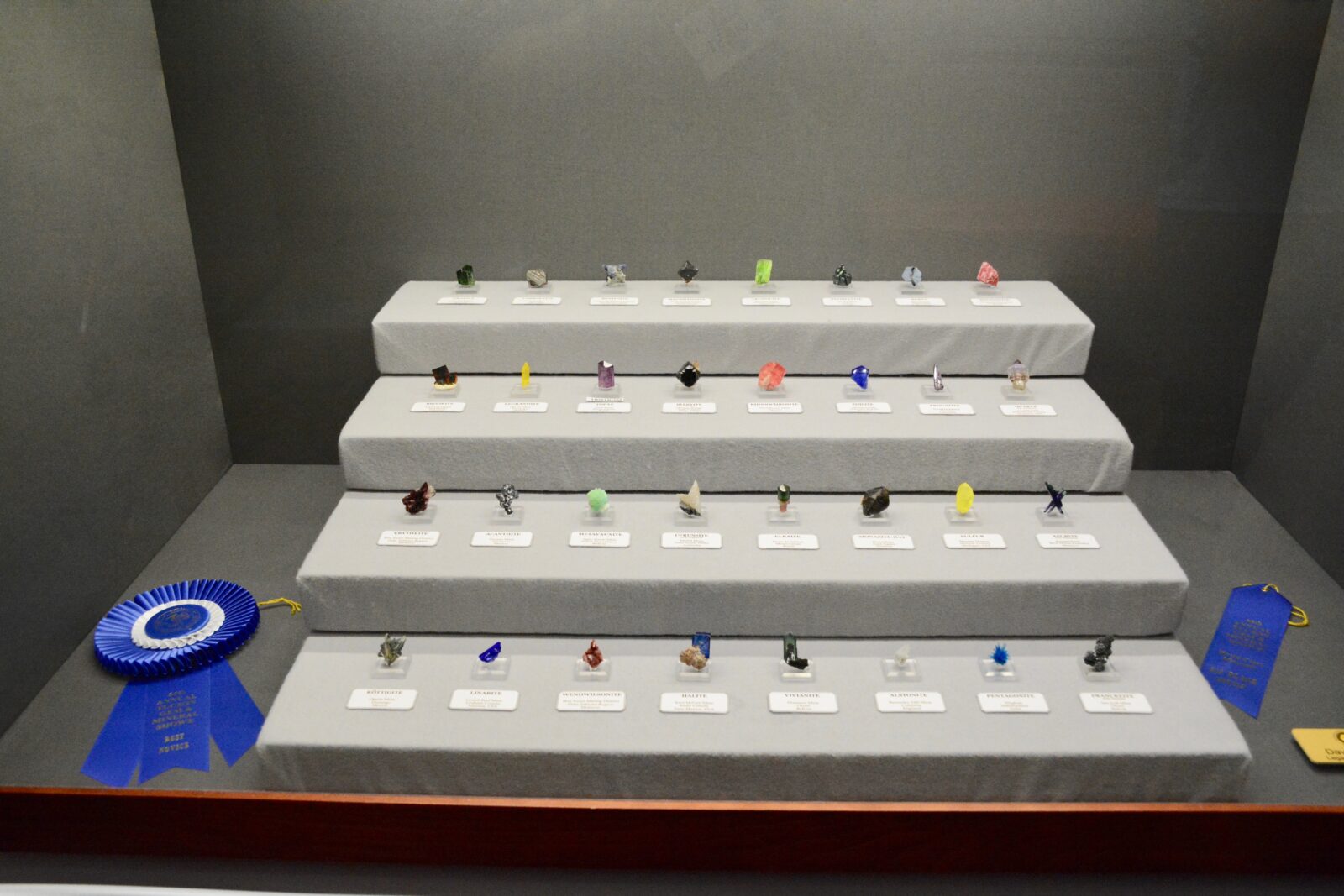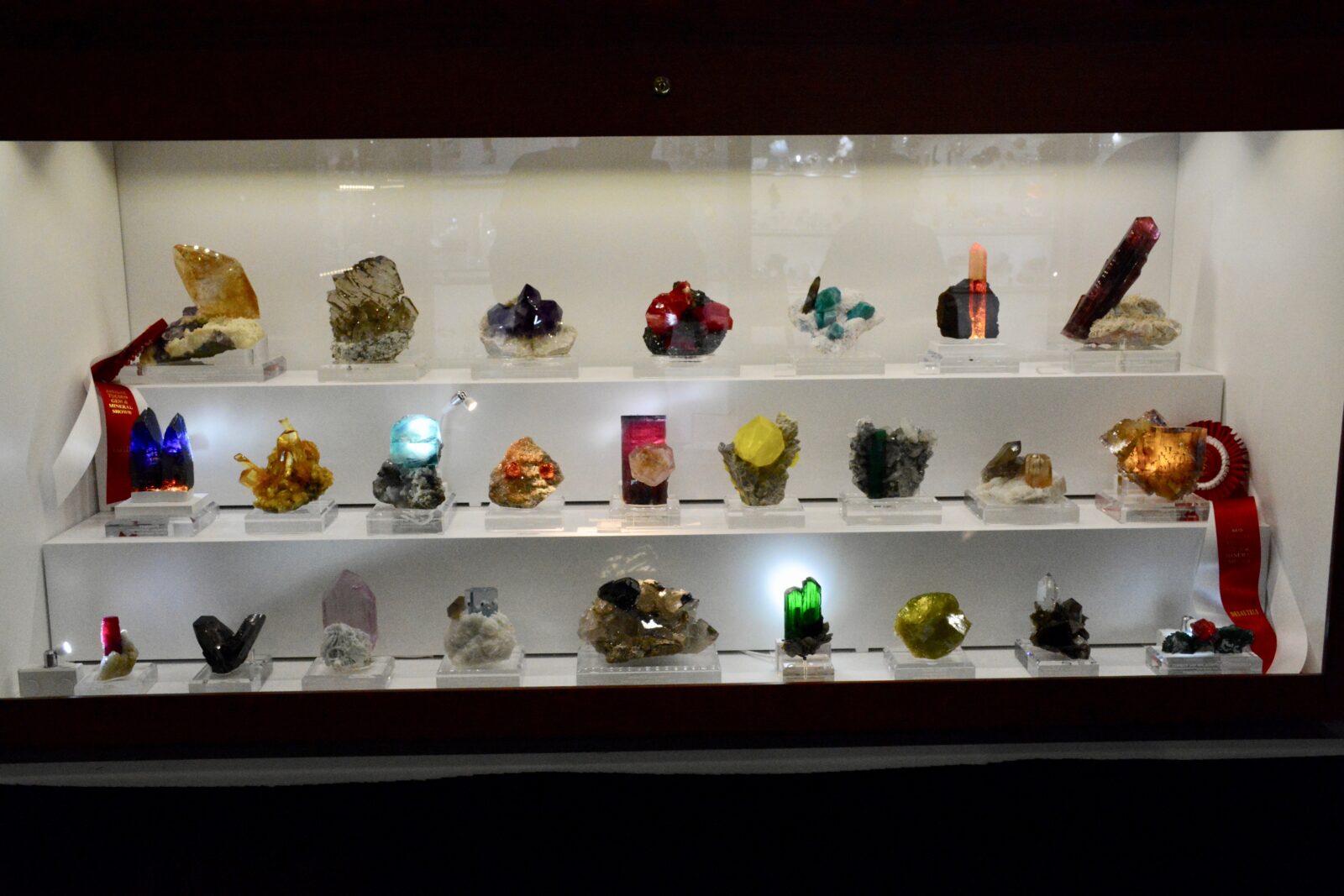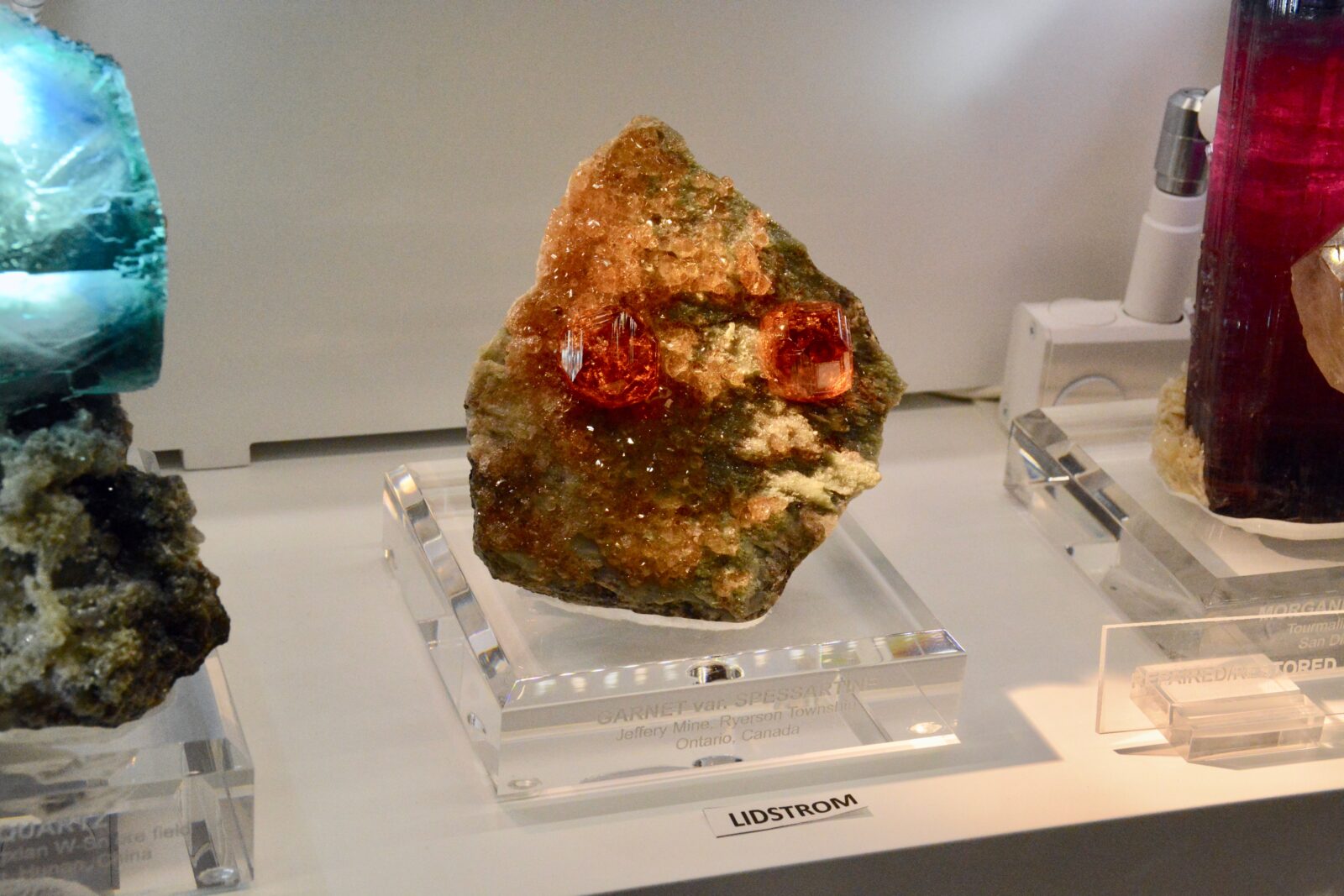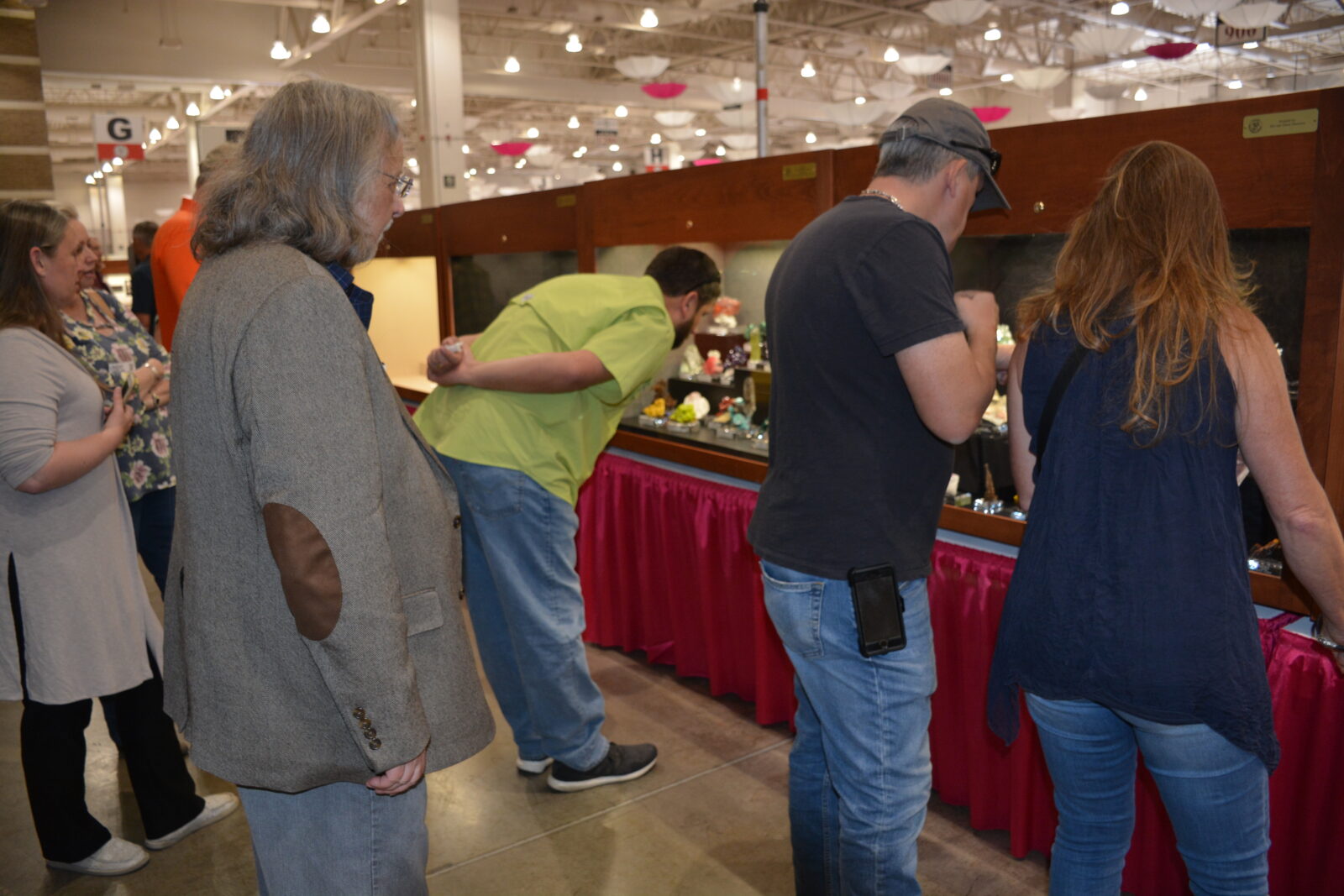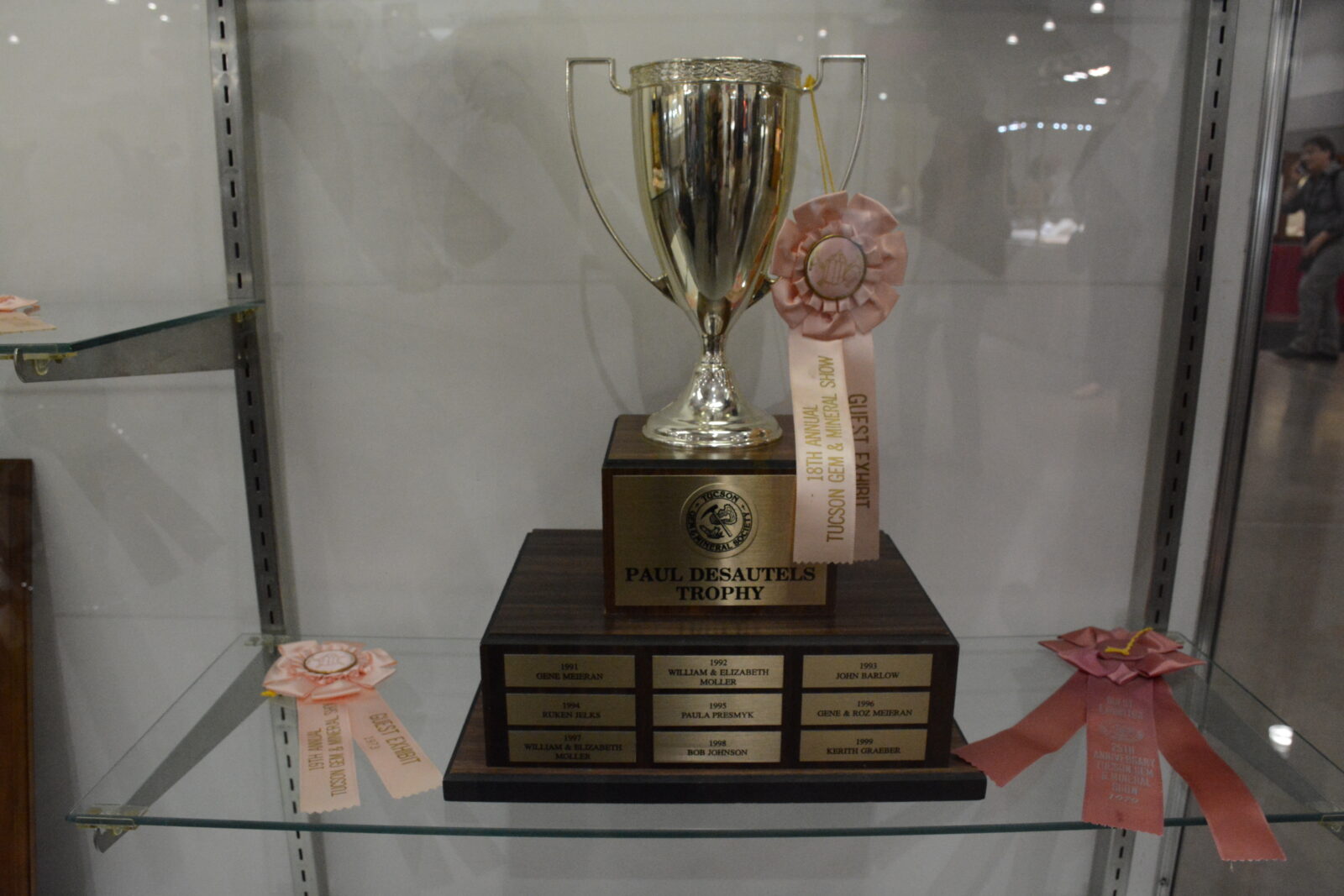Why Competition? Two Perspectives
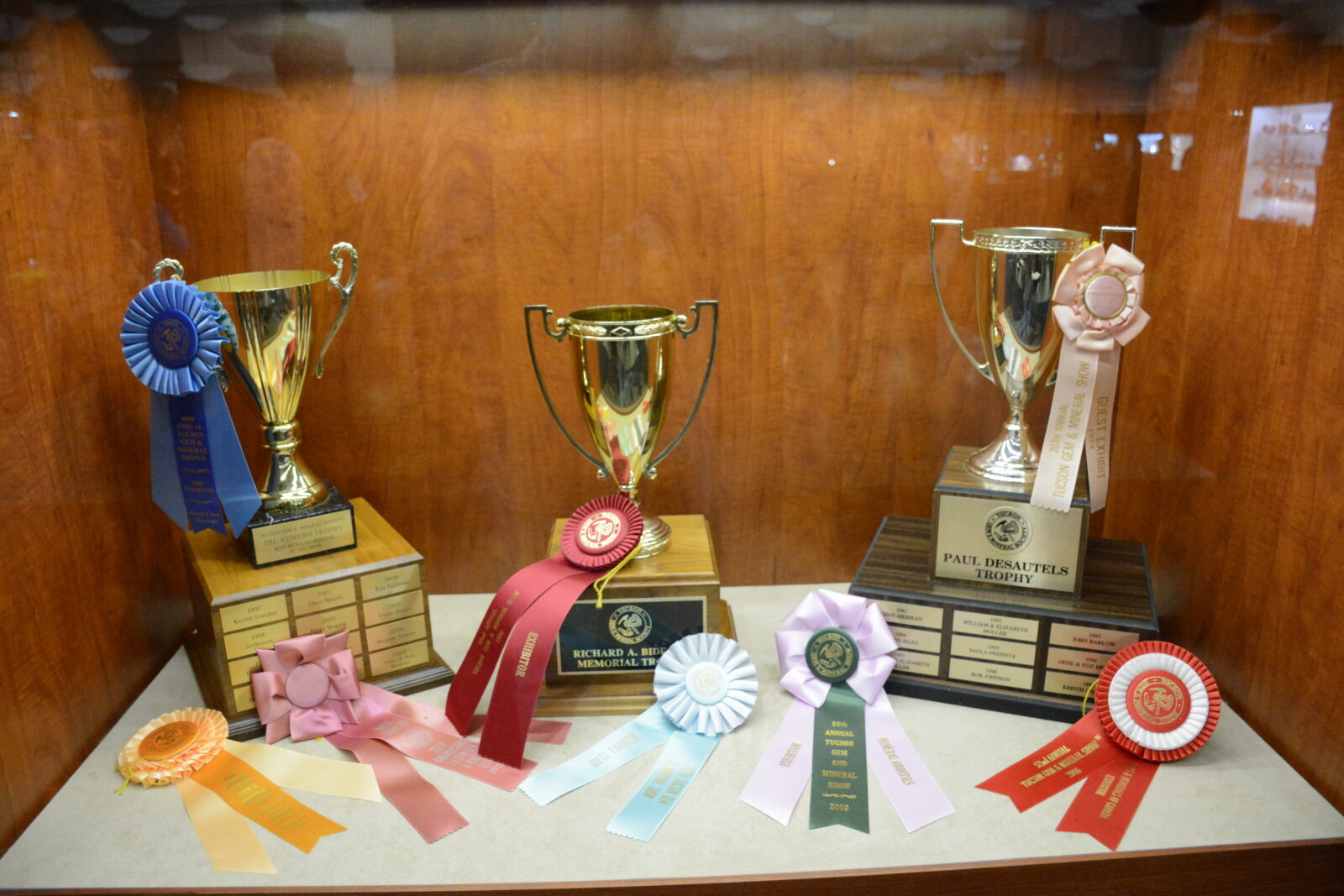
Adapted with permission from the Mineralogical Record, volume 51, July–August, 2020, for publication on iRocks.com.
Les Presmyk
610 South Bay Drive
Gilbert, Arizona 85233
Marc Countiss
1427 Fall Wood Drive
Sugar Land, Texas 77479
The Tucson Gem and Mineral Show is a hotbed of mineral-related activity, camaraderie, wheeling, and dealing, discussions, arguments, and general wonderment. One of the most exciting aspects is the competitive displays. Any collector can enter minerals in competition and doing so will provide a whole new and gratifying show experience—win or lose! The authors present here some thoughts, observations, background, and experiences designed to encourage more competition at shows.
Perhaps a better question is why not? Competition is something we live with every day in school, in our jobs, our sports, and our elections. Almost everything we do or are involved with includes some form of competition. So why should our mineral hobby be any different? Some collectors want to have the best thumbnail or miniature collection or find the best pocket of some mineral—or at least the best pocket they ever found through self-collecting.
Competitive mineral exhibits have been a part of mineral shows since their very beginnings. When the Tucson Gem and Mineral Show® began in 1954, the founders encouraged competitive as well as non-competitive displays. Today those displays are more fascinating and interesting than ever.
LES PRESMYK’S PERSPECTIVE
The very first time I exhibited, at the age of 11, it was to compete at the Arizona 4-H Fair with a wooden box containing 24 thumbnails. Then it was on to the Arizona State Fair, which at the time represented the largest and best mineral competition in Arizona. There was actual prize money, and other young exhibitors like Wayne Thompson, as well as numerous adult collectors including Bob Jones, Harry Roberson, Tom McKee, and Edna Andregg, just to name a few, enjoyed competing for trophies and award money. I attended my first AFMS national show when I was 17 and was fortunate enough to win the Junior Trophy. For me, competing has become second nature. It has always been about seeing how an exhibit was improving, how the judging was being done at other shows, and, of course, it was about winning if possible.
Back when minerals were not as valuable in dollar terms as they are today, people seemed more willing to compete. There is always a risk in packing and transporting specimens; when specimens did not carry high values, collectors were more willing to travel to shows and display their collections. Today, if an elite collector is putting in a case of 25 minerals, some with a price range of $25,000 to $250,000, this is a significant amount of money to place at risk. But the enjoyment of showing their collection to thousands of show-goers and friends, comparing their minerals with those of other collectors, and receiving authoritative feedback from a team of highly knowledgeable judges, makes it all worthwhile.
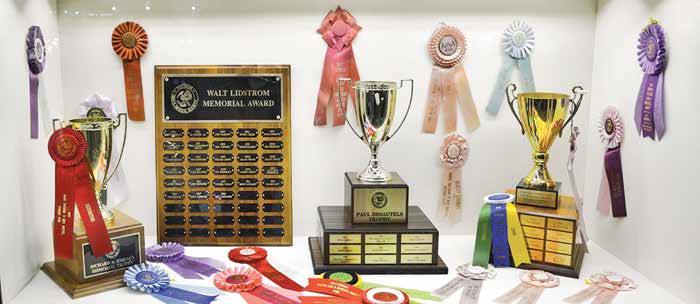
There are two basic types of competition, the American Federation of Mineral Societies (one national show per year and seven regional federation shows) and the Tucson Gem and Mineral Show®. The AFMS Competitive Exhibitor’s Handbook contains hundreds of categories including lapidary and jewelry, fossils, minerals, micromounts, and educational. It used to be that all miniature size cases competed against one another for a single national trophy, so a display of specialized miniatures had to score more points than a case of worldwide miniatures of 25 different species for the same trophy. It could be rather discouraging to put in a fantastic case of calcites, for example, when you knew you could be competing against azurites, golds, and 23 or so other varied species from localities worldwide. Now, there are trophies available in many different categories, and in the case of minerals, there are general classes, like worldwide miniatures or thumbnails, and trophies for the restricted classes for various sizes.
In order to compete for a national trophy, an exhibitor must first receive at least 90 points out of 100 at a regional show to qualify for national competition. This could include a first-place ribbon and maybe even a regional trophy but not necessarily. I have seen thumbnail competitions where the fourth-place exhibit still received 91 points so all four became qualified to enter the national trophy competition.
At the Tucson Show®, we allow exhibitors to compete in any of the myriad of categories listed within the AFMS exhibitor’s handbook, but the 15 or so categories in the Tucson Show® handbook have generally met the needs of Tucson competitors. At Tucson, there are two levels for Junior exhibitors and three levels for adult competition. For Juniors, there is the regular Junior level which is the entry-level. Once a Junior exhibitor has either won two blue ribbons in a category or taken the Best Junior trophy, they must thereafter enter in a different category or move up to the Junior- Master level. This was instituted to allow the Junior-age exhibitors to continue competing against other Juniors rather than being required to compete in the adult categories. As an adult (18 years or older) a person can start in the Novice division and move up to Advanced and finally to Master level. However, there are no restrictions about entering directly in Masters if that is your quality and comfort level.
Competition at the Tucson Gem and Mineral Show stresses several aspects: showmanship, accuracy of labeling and rarity are all important, but the quality of the specimens is paramount. The goal is to make the judging as fair and unbiased as possible. The Tucson Show® is very interested in educating exhibitors about what is good in their exhibit and what steps they can take to improve their display. All judging teams are encouraged to provide feedback to each exhibitor regarding labels, showmanship, and especially the quality of their specimens.
The real difference between AFMS and the Tucson Show® is in the judging. The AFMS uses qualified judges who work in teams of two, evaluating the entire case including labels, showmanship, rarity and quality. They judge during the open hours of the show. So, while the judges stand (or sit) in front of a case, they know they cannot speak too loudly for fear of someone hearing their comments, nor do they have permission to ask another judge or judging team about a particular specimen, especially in thumbnail cases.
At Tucson, judging teams are used but in a very different way. There is one team judging rarity in all of the cases, one team for showmanship, and one team for labels. This provides consistency across all of the exhibits, regardless of exhibitor level. Then there are three teams, each consisting of a judge and a clerk, who independently judge the quality of every specimen. The judging takes place after the show is closed so conversations can take place freely regarding any questions the judges may have. The quality of each specimen is judged using a scale of 1 to 10. The clerk (who is either a quality judge-in-training or a quality judge) records the score so the quality judge does not see how the other judge or judges have scored the specimens. However, and especially with thumbnails, there are sometimes species not every judge may know. If the quality team cannot figure out how good something is, they are encouraged to ask the other quality judges or the judging chairman.
When it comes to the Best of Species competition and the other special trophies like the Bideaux (best Arizona specimen), the Lidstrom (best single specimen in a competitive exhibit) and the Desautels (best case entered for this trophy, recognizing “the best case of rocks in the show”), it is the three quality judges who join together to form the team who determines those winners. No scores are given, and any previous scoring of a case entered in competition for a special trophy is not known or used. This team now examines each specimen and each case to determine the winners. The Denver Show, on the other hand, awards several special trophies and under their system all of their judges award scores for all of the entries. Both systems work well because when it comes down to it, the goal is to provide as fair and unbiased/impartial judging as possible.
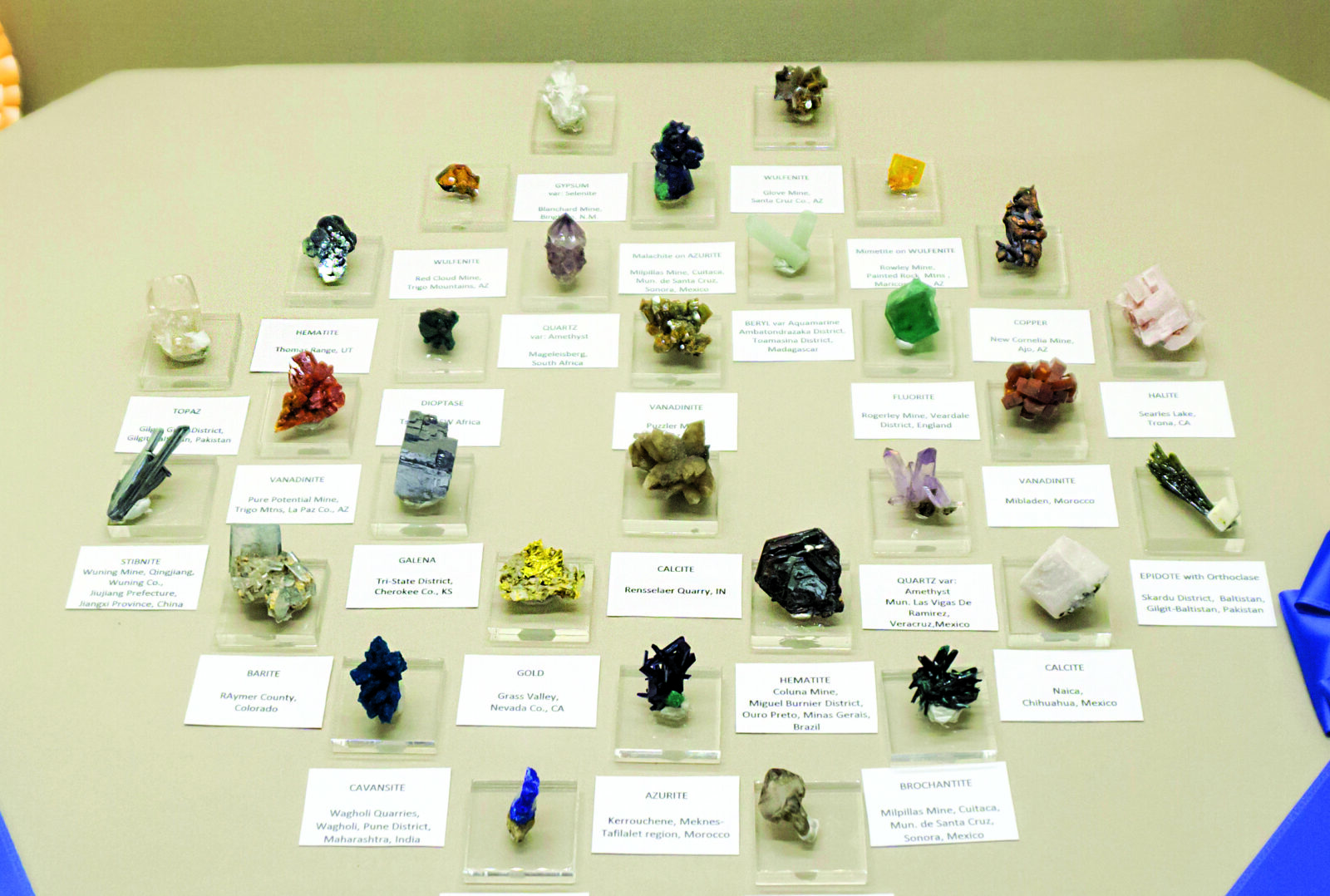
Now let’s talk about the human factor in all of this. Like it or not, judges aren’t perfect; they are just human beings. For the Tucson Show, I always do my best to select knowledgeable mineral collectors, which have included dealers and museum curators, as judges. I also try to select judges who have competed in the past. Although dealers are many times the most knowledgeable about the availability of specimens, being a judge can put them in the awkward position of having to judge other dealers’ minerals (owned by the collectors they have sold to). And yet we still occasionally have dealers who are willing to share their expertise as judges. All potential quality judges spend at least their first year as a clerk. Each quality judge knows they are also training future judges. In addition, I provide each judging team with written guidelines about judging and a quality scale to help provide as much consistency as possible.
For the exhibitor, sometimes, it’s just bad luck. For example, a number of years ago a thumbnail collector brought an exhibit that included a large but somewhat etched cumengeite. For a thumbnail it was not the best one I had seen but it was at least a 9.5. However, the judges gave it around a 9 or 9.25 for two reasons. One was because of the pitting and the other was because the Sorbonne had brought all three of their fabulous cumengeites to exhibit. Now, all of them were small to medium size miniatures but the museum specimens stole the thunder from the smaller specimen in the competitive thumbnail case.
Another fault of human nature appears the first time a judge sees a great specimen; the initial shock value may generate a 9.75 or 10-point score. The next year the same exhibit shows up, even though this is still the best specimen anyone has seen (and not because they just found a quarry full of them in India) the piece may score only 9.5. And the third year it may drop even further. This depreciation of impact value is not mere conjecture; a top thumbnail collector and competitor kept track every year for the three years he competed with his thumbnail exhibit at Tucson and documented the declining scores.
There are two ways we try to minimize this effect. One is to rotate the quality judges so that every year there is at least one judge who did not judge the previous year. And, the fact that there are three quality judging teams is paramount. No matter how much the three judges may differ on a particular specimen, the total quality scores on any particular case are nearly always within just a couple of percentage points of each other.
The second mitigating factor we use is the point at which the first, second and third-place ribbons are awarded. In AFMS competition you must achieve at least 90 points to win a first-place ribbon. At Tucson, in the Masters class, the threshold is 85 points, Advanced is 75 points and it drops as low as 60 points for a Junior exhibitor. Not that the standards are lower in Tucson; just the opposite. In fact, one collector noted that the scores he was awarded by AFMS were often 10 points higher than he received from TGMS judges. In Tucson we place greater emphasis on specimen quality. Another example is labeling. In AFMS, labeling is worth 10 points and you lose 2 points for every labeling error; at Tucson it is 1⁄2 point. In the Masters class, there are only 6 points for labeling and in all of the other exhibitor categories it is 10 points. While accuracy in labeling is certainly important, it should never overshadow the quality of the specimens.
There is no question that the willingness to compete at all levels has diminished in recent times. Thirty-five years ago, at the Tucson Show® there were around 40 competitive exhibits, but for the past 15 or 20 years, that average has been closer to 20. Denver and Federation competition has seen the same declining trend. Certainly, the value of specimens may be a deterrent. As mentioned above, we all know that when you handle, pack and transport your specimens there is a risk of breaking something. In 2017, we (Les) moved 660 specimens from Gilbert, Arizona to Springfield, Massachusetts to fill 52 display cases at the East Coast Gem & Mineral Show. Not a single specimen was harmed. However, during the process of moving specimens around at home while preparing the cases, three specimens were slightly damaged.
Year after year, collectors are more than willing to put in non-competitive displays at the Tucson Show® but have no desire to compete. And considering that 1001 displays are brought to the Tucson Show® each year, of which around 20 are competitive displays, it is clear that many collectors are still willing to display their collections. So why should a person compete?
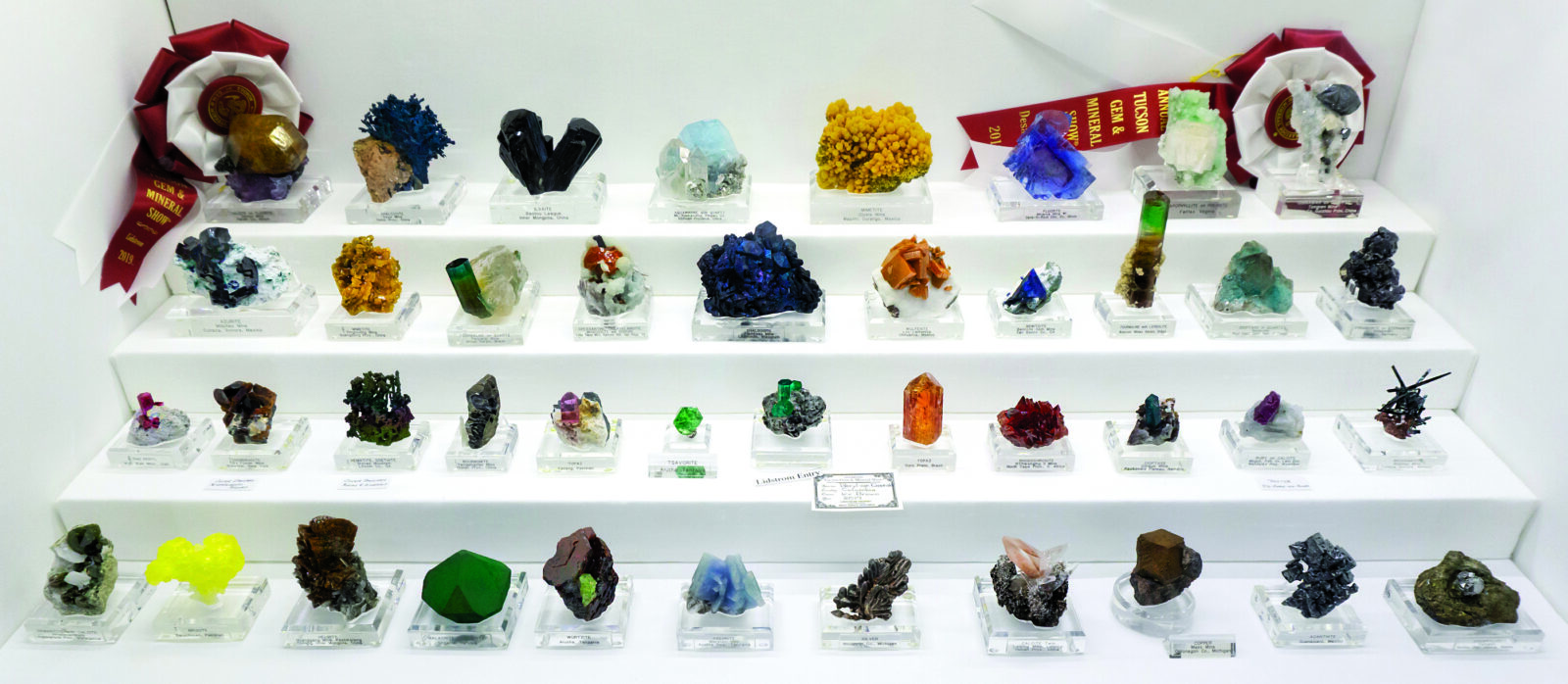
The level of competition and the judges at the Tucson Show® are the best in the country. As has been described by more than one collector, the Tucson Show® is an ever-changing, temporary four-day world mineral museum exhibit. There are exhibitors who compete at Tucson who do not compete anywhere else because of the prestige of the show and the level of competition. There is a large pool of knowledgeable and willing mineral collectors to do the judging. So, it is like the World Championships every year, with the expectation that one or more of the top collectors will bring an exhibit to vie for the Best of Show in Masters as well as for the special trophies in the Desautels, the Lidstrom, the Bideaux and Best of Theme categories. Over the history of the Tucson competition and its special trophies, most of the winners of these awards have gone to everyday collectors who bring their best specimens or have a really great theme specimen or Arizona piece that takes home a trophy. Like the Lottery, you can’t win if you don’t enter.
I have been the Competitive Exhibits and Judging chairman at the Tucson Show® for the past 34 years and started judging in 1979. During that time, there have been three generations of Junior exhibitors I have helped mentor until they graduated from high school and went off to college. They came back every year, with better specimens and better showmanship while certainly correcting their labeling mistakes, to win the blue ribbon and ultimately a trophy. One of the other incentives has been provided through the generous assistance of Dr. Rob Lavinsky of The Arkenstone. He has given $100 to each Junior exhibitor just for exhibiting and then another $200 for the second-highest score and another $400 for the highest scoring junior age exhibitor for the past 10 years. After competing for over a decade, one of these young exhibitors, Lauren Megaw, won the Desautels at the age of 19! The Flagg Mineral Foundation and the Mineralogical Society of Arizona have supported the Phoenix area Junior collectors as well and encouraged them to compete in Tucson.
Competitive exhibiting is something every collector can do, regardless of their budget. Gretchen Luepke-Bynum, who exhibited competitively for decades, was such a collector. She had a limited budget coupled with a boundless enthusiasm for exhibiting and competing. She collected (1) world-wide thumbnails, (2) miniatures and (3) small cabinet-size specimens. So, every third year she would enter one of the three size categories, each time showing some improvement in her displays. She started as a college student in the Novice category and worked her way up with each of her collections. When she finally won her first Novice trophy it was a very proud moment for her. And it was another great moment when she won the Advanced level trophy. She was a fixture in the competition and the only show she missed was when she was recovering from knee or hip replacement surgery. She had far more white and red ribbons than blue ones, but I always admired her willingness to put her collection and herself out there.
TUCSON’S SPECIAL TROPHIES
Best of Species/Theme
The original idea for this competition came from an editorial written by John White in his early days as editor of the Mineralogical Record. The premise was to select a particular species that would be featured at various shows throughout the country and then bring the winners from each show to one show and have a run-off competition for the ultimate winners. The Tucson Show® Committee adopted this idea almost immediately, initially choosing minerals well represented in Arizona. The first competition was in 1972, the mineral selected was wulfenite, and this was before show posters and show themes were instituted. The next few years the favored topics included azurite, malachite, pyrite, and barite. The first deviation came when rhodochrosite was selected, a mineral that has few localities in Arizona, none of which are noteworthy. In addition to selecting a single species for competition, the Tucson Show® Committee has also selected significant locality areas such as Western Europe, Mexico, Australia, and even specific states like Arizona and California, to name just a few.
The Denver Gem & Mineral Show initiated its Best of Species/ Theme competition in 1992. As far as I know, these are the only two shows that have adopted this concept. Once posters began to be produced by the two shows, the poster mineral has coincided with the best of species/theme.
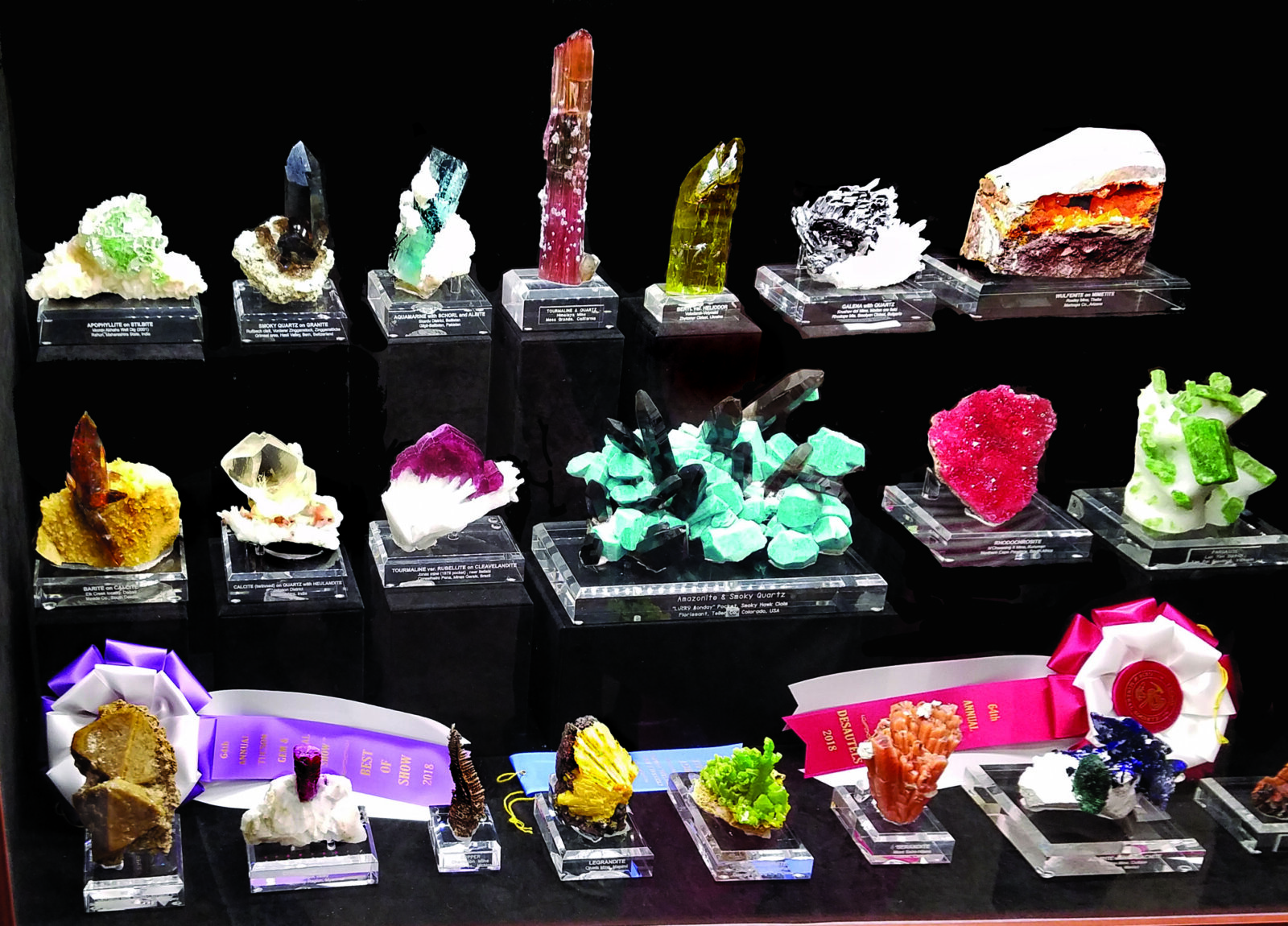
McDole/Desautels Trophy
The McDole Trophy was initiated in 1975 by John Patrick and Al McGuinness to honor the memory of Ed McDole, a hardrock miner turned mineral collector, who collected a number of fine pockets throughout the West and was a fixture at the Tucson Show®. The only criterion for judging was that “the best case of rocks” would be selected, no points given for labeling, and no consideration of showmanship—just the minerals themselves.
Every year, the judging team consisted of John Patrick, Al McGuinness and one of the quality judges from the Tucson Show’s competition judging team. Then the trophy was presented by John and Al during the Saturday night program. This was accompanied by the requirement that the winner knock back a shot of Old Bounders rum from a bottle supposedly owned by Ed McDole himself (although Ed McDole did not drink). After Al passed away in 1995 the McDole trophy was retired at John Patrick’s request and the Show Committee initiated the Desautels Trophy in its place, honoring former Smithsonian curator and mineral connoisseur Paul E. Desautels, who had died in 1991. The award still recognizes the best case of minerals in the show entered in this competition.
Lidstrom Trophy
Walt Lidstrom was a dealer in the show who started out as an agate collector and dealer. He quickly became one of the premier mineral dealers at the Tucson Show® and was always generous with his encouragement of young collectors, including me.
With his passing, his family funded a trophy to be awarded to the best single specimen, selected for consideration by an exhibitor, contained within a competitive exhibit. The specimen being selected by the exhibitor has always been the most interesting part of this competition. There are numerous examples of the exhibitor (including me) selecting the wrong specimen, or at least not the specimen the judges would have awarded the trophy to had the collector chosen that piece.
Bideaux Trophy
Richard A. Bideaux was a lifetime Arizona mineral collector and mineralogist who was also a computer expert. Upon his passing in 2004, The Tucson Show® committee decided to honor his memory with a competition and trophy for the best Arizona specimen entered for consideration.
MARC COUNTISS’S PERSPECTIVE
I (Marc) have collected minerals for 40 years but consider myself to have been a serious collector since 2001. My wife Janis joined me in the hobby after the specimens that I brought home finally infected her with the collecting bug. The best way to define “serious” for us is being willing to spend an amount which causes some very careful internal debate before buying. Not surprisingly, this amount has increased over time as our tastes have evolved and mineral prices have risen. But it also means buying pieces that would, in the opinion of most experienced collectors, rank high for overall quality and appeal. Once we became serious, we continued to view it as a hobby and not as an investment, even though it captured a considerable portion of our discretionary funds. But we strove to acquire the very finest that we could afford. The thought was that someday we would divest the collection and we wanted to have a chance of recouping at least some of the cost. This is a pretty common theme among devoted collectors.
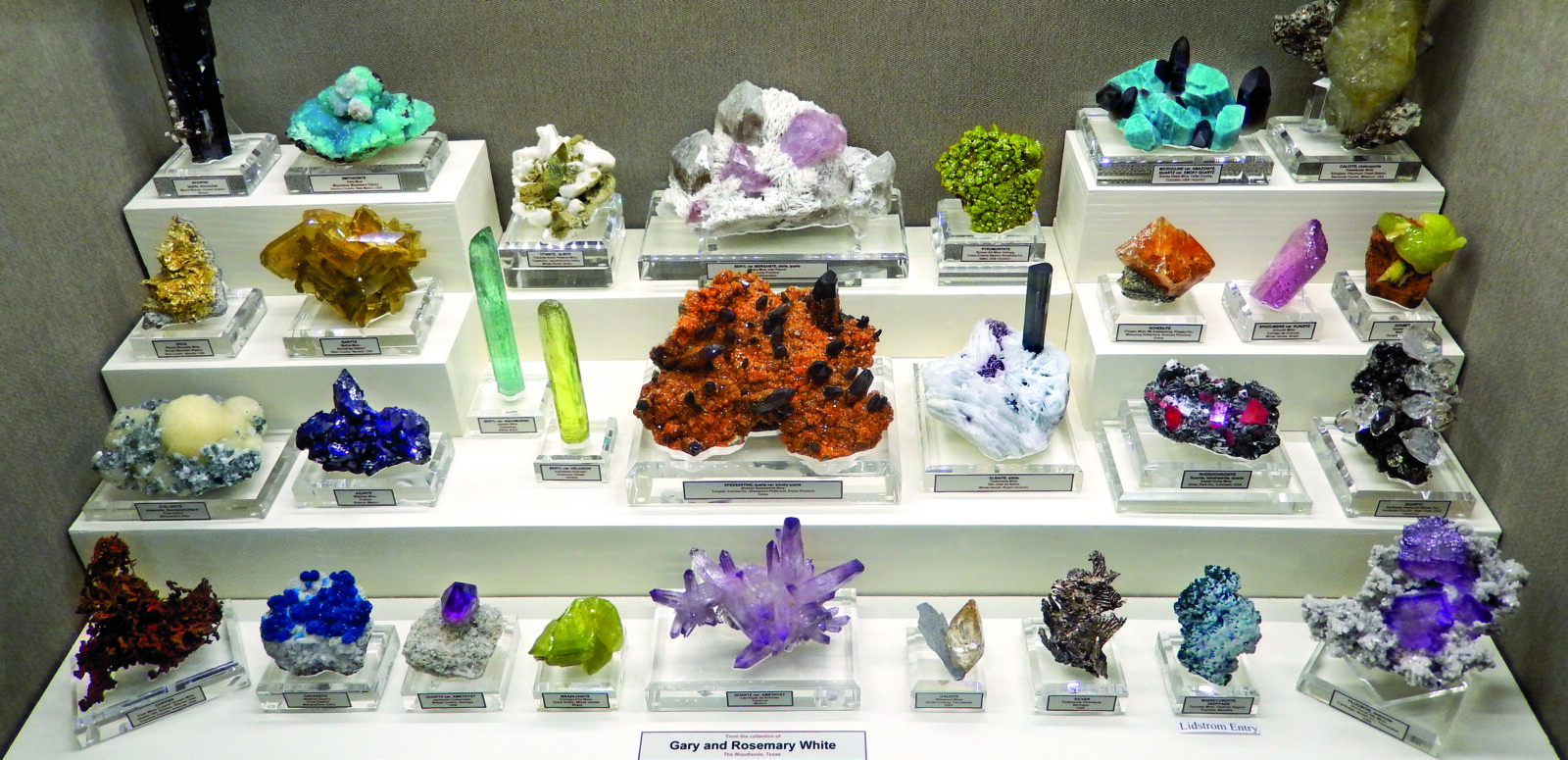
We followed the traditional path of going to Tucson and Denver regularly, as well as various other shows. Early on in the Tucson adventure, I and my collector friends would sift through every room, tent and parking lot we could find. There was far more trash than treasure to be seen, but it was exciting nonetheless, and educational. Janis and I also went to museums and saw as many private collections as possible. This gave us a very good sense of what constituted an exceptional specimen in most collectors’ minds and helped us focus on what appealed to us.
The Houston Area Mineral Society (HAMS) was inaugurated in 2004 to foster a growing group of like-minded collectors in our area. This group also accelerated our education regarding fine minerals and facilitated the exchange of ideas and information on collecting.
Mineral collecting has been a captivating and exciting adventure for us. We are always eager to see what new things the dealer community has brought to each show. We enjoy visiting with the many friends we have made over the years and hearing about the new treasures they have found. Minerals hold a fascination that is difficult to express, but Rock Currier did a fine job describing it in his series of Mineralogical Record essays entitled “About Mineral Collecting.” In his treatise he referred to one’s mineral collection as their “precious children.” This seems to effectively convey the passion serious collectors have about their specimens. So how did this lead to competing?
Tucson hosts what is widely regarded as the largest and most influential conglomeration of mineral shows on the planet—dubbed by the City Fathers as the “Tucson Gem, Mineral and Fossil Showcase.” The Tucson Gem and Mineral Show (TGMS), also called just the “Tucson Show” or the “Main Show,” is an entity separate from, but related to, the Tucson Gem and Mineral Society (also called the TGMS) that originated it, and now has its own board of directors. The Main Show is the culmination of this multi-week, multi-show extravaganza each year. The TGMS mineral competition is also seen as the most prestigious event of its kind. Past winners comprise a Who’s Who of modern mineral collecting history. The names are known throughout the hobby, and to be listed among that group is a high honor indeed.
Over time we began to wonder how our collection would rank with the best. How would we fare against Gail and Jim Spann, Barry Kitt, Gene and Roz Meieran or any of the long list of notables who have competed and won? For us to end up on top when compared to those collections seemed unlikely. Nonetheless, we began to believe that we could be competitive at a high level and we became curious about how we would fare in an exclusive contest.
HAMS member Brent Lockhart suggested several years ago that we consider competing at the TGMS Main Show in Tucson. At first, we disregarded his suggestion because we did not think our collection was ready for competition, but he thought we had a chance. Brent won the Lidstrom trophy the first year he competed in 2014, for his wonderful Elura mine mimetite. He persevered to win the Desautels Award in 2016. Brent’s experience gave us confidence that his opinion should be trusted, and that encouragement would ultimately convince us that we should give it a try.
We finally decided to put our collection in competition for the first time in 2017. The trail had been blazed by Brent, along with other HAMS members, all of whom had some level of success in the TGMS competition. Mineral collecting has been such an integral part of our lives over the last 18 years that it felt like competing would be the next logical step. Collecting has been the focus of much of our travels and social events. So many friends have been made through our connection with this hobby. So much of our time and interest has been tied to minerals. It was not so much about winning an award as it was about all of those things. But win or not, we wanted to have the experience of competing in the mineralogical Mecca of Tucson, to complete our collecting legacy.
Deciding to compete is a major step forward, but then what? For most people the next step is a bit unclear. How do you enter? What are the various competitive categories? What exactly are the rules and where can they be found? Which of our pieces should be included in an exhibit? Most collectors are aware of the TGMS competition but largely unacquainted with the details. There is a set of Uniform Rules of Competition published by the American Federation of Mineralogical Societies (AFMS) that govern min- eral competitions at Federation shows. It is a hefty volume but the basic rules and definitions are covered in the first 12 pages. After that, the remaining 70 or so pages are devoted to specifics of the different divisions of competition (minerals, lapidary, fossils etc.). There is a class for everything “mineral” in this set of competition rules.
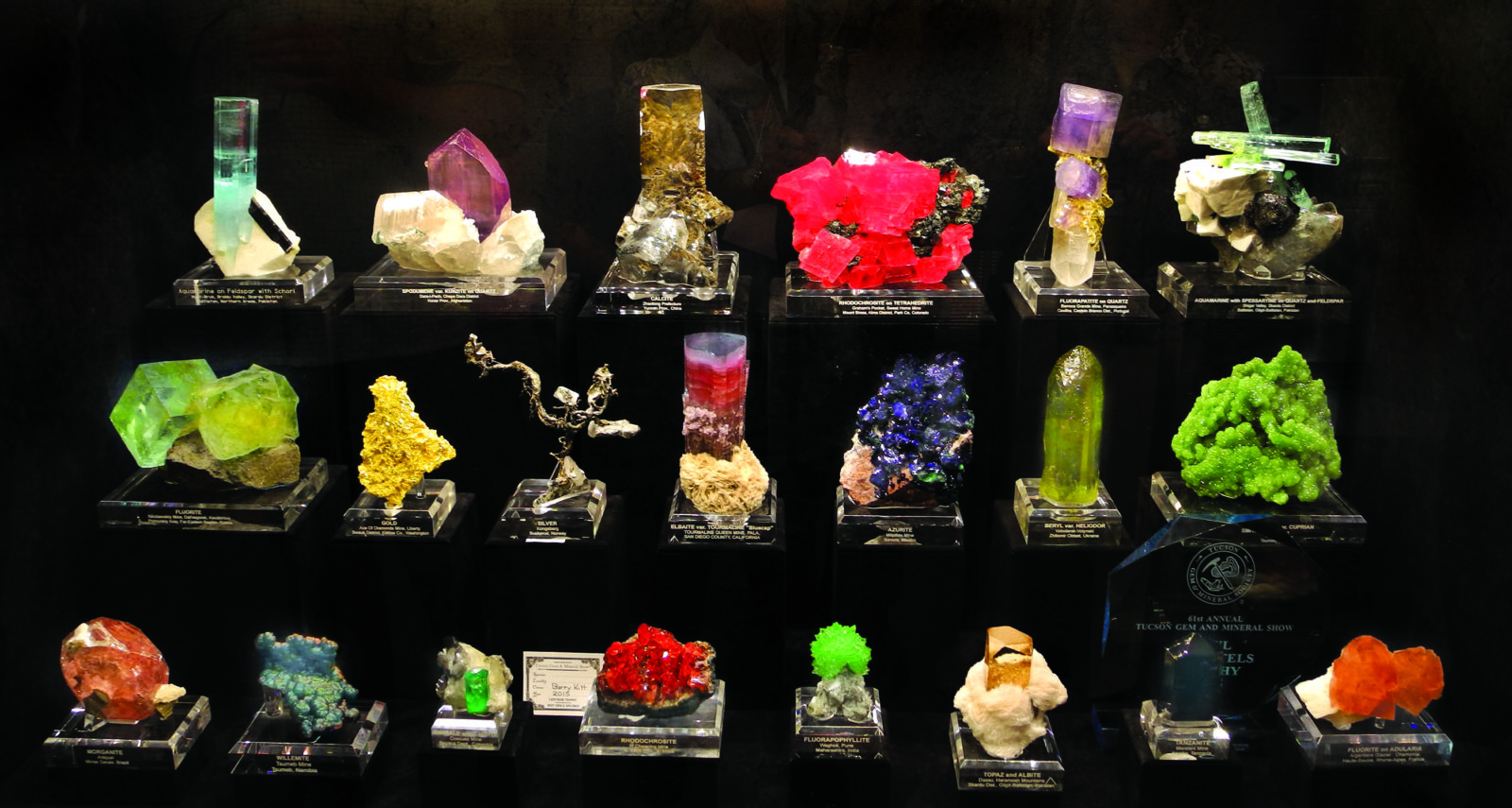
But TGMS has a unique set of rules described in its Competitive Exhibitor Handbook governing the TGMS competition in Tucson. The handbook describes the various exhibitor groups, competitive divisions and assorted awards. It also discusses classes for mineral exhibits and the criteria used in judging and scoring. Within the regular exhibitor groups (Junior through Master), TGMS rules allow for a minimum of 20 specimens of the mixed size and type division. This is one of the most common divisions of competition in Tucson. Competition is also common in the categories for miniature-size and toenail-size specimens (the “toenail” size category was initiated at the Tucson Show® as the intermediate size between thumbnails and miniatures), also with a minimum of 20 specimens required. The thumbnail class calls for at least 30 specimens for qualification. The special trophies (Desautels, Lidstrom etc.) each have their own separate set of requirements. A copy of the handbook can be requested from TGMS for further details.
Soliciting opinions from other collectors who have competed in Tucson is advisable, as there are some considerations that may not be apparent to the uninitiated. The general tendency for a collector is to select specimens for competition based on value rather than quality. Not that high-value pieces won’t score well, but in the regular exhibitor groups, quality is 75% of the score (85% at the Master or highest level) and dollar value is not necessarily a consideration. We have received very high scores on pieces that were not expensive. “Trophy rocks” can certainly provide an edge in the special award categories such as the Desautels or the Lidstrom where so-called “killer rocks” can move the needle. But to win in the regular competition divisions, all of the well-known quality criteria of form, color, luster, lack of damage etc. are most important. These are what the Tucson quality judges are looking for.
The regular competition groups are determined by a composite point score while the Desautels, Lidstrom and Bideaux Memorial Trophies are based on the majority opinion of the judges. So, it is not uncommon for a competitor to win Best of Show (the highest award at the Masters level of regular competition) but still fail to win the Desautels Trophy. Sometimes this is due to a competitor only entering for the Desautels and Lidstrom awards while not entering the regular competition.
Looking at our collection with a very critical eye, we immediately see all the imperfections. We are inclined to compare our pieces to things we have seen in the most elite museums and private collections in existence and feel inadequate. Competing against that level of quality may bring disappointment. But the reality is that museums do not compete, and the most elite collectors do not compete very often, if ever. However, Tucson annually attracts a group of fine collections for display so it benefits you to bring your best. It is typical to select personal favorites, but getting outside opinions on what pieces to include in a competitive exhibit can help to be objective. Ask four or five collector friends whose knowledge and judgment are trusted to help select a group of specimens that are the top tier.
Once the decision is made on the pieces to be included, the next step is to consider how to display them. Building a set of risers and case liners to make the exhibit look professional and appealing is worth the effort. Having been co-architect of past HAMS exhibits at the Tucson Show has helped me to prepare the proper display components. TGMS supplies very accurate dimensions of their exhibit cases, so a set of risers and liners can be constructed that will simply slide right into the case. Be mindful that a portion of the score is dependent upon showmanship and labeling accuracy as well as points for rarity.
Set up day can be stressful, and we have witnessed multiple competitors attempting to decide on the arrangement of the specimens in their exhibits under the duress of a bustling show floor. One recommendation is to stage the exhibit in a trial run before arriving in Tucson. This will allow time to experiment at leisure and achieve the most complimentary arrangement possible under calm conditions. Once the final display arrangement has been determined, photograph it to assist with the actual deployment.
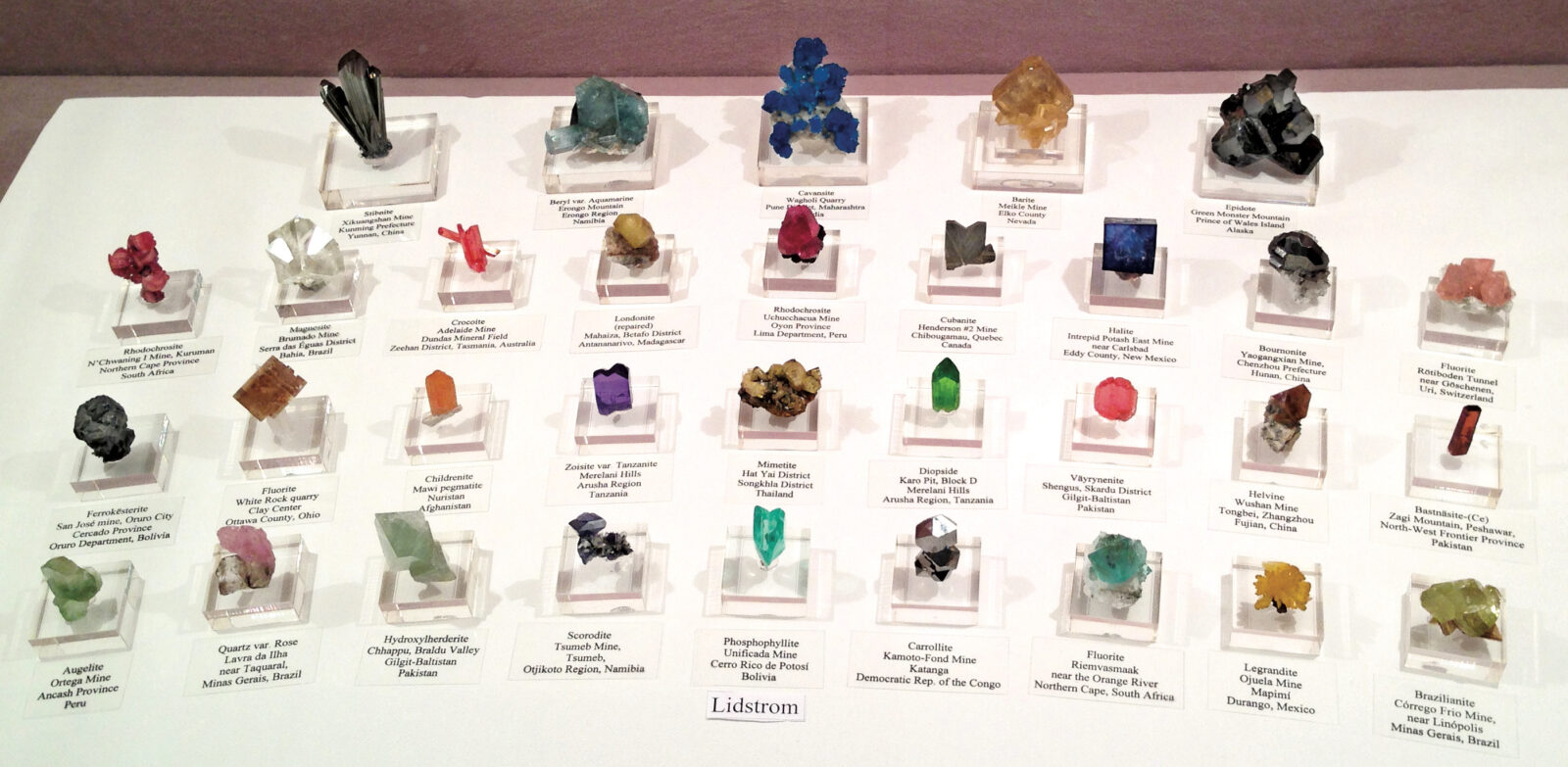
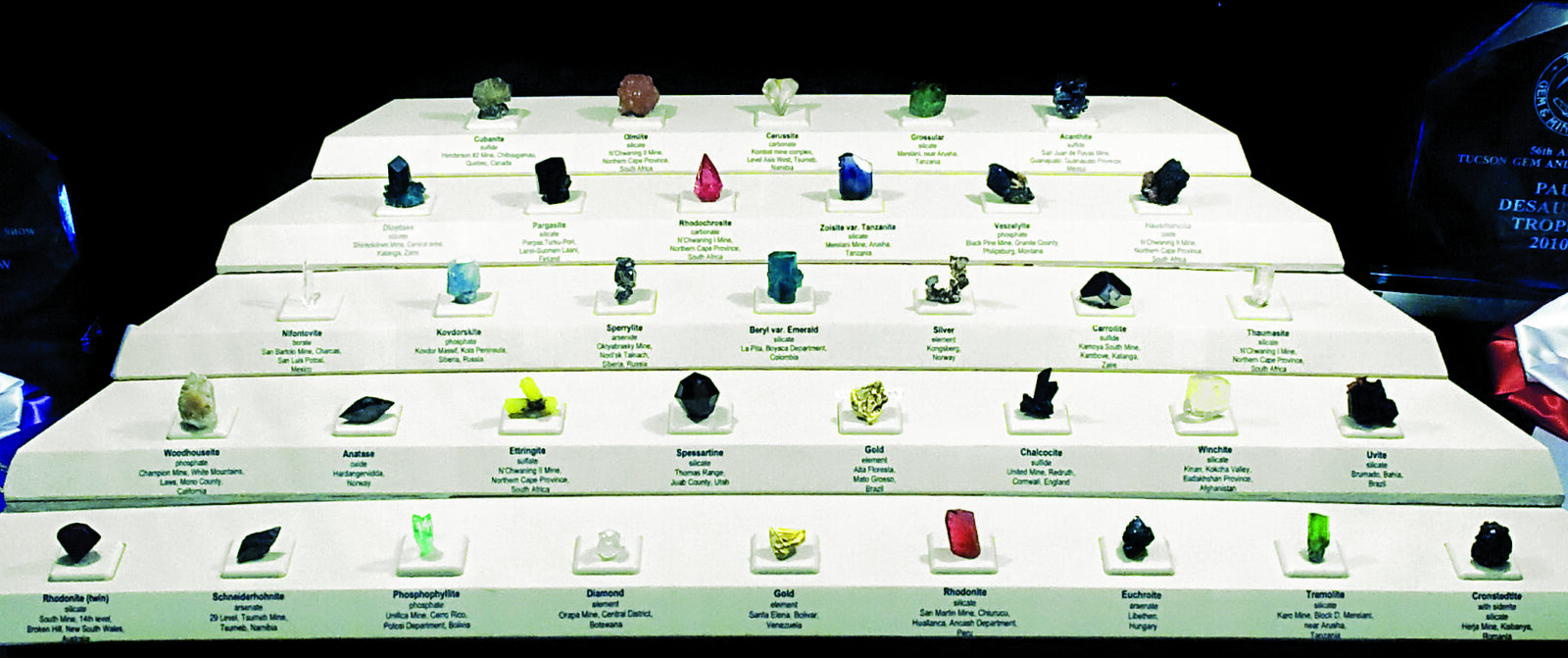
We felt some anxiety prior to our first competition because of uncertainty about how our exhibit would be received by the judges. The results did yield some surprises, mainly related to how our specimens were ranked, but that should be expected. Judging a fine mineral competition is a subjective task and is predictably influenced by each judge’s knowledge, experience and personal preferences. If a judge seems critical, remember that all competitors are evaluated by the same panel. They genuinely want to make fair decisions based on the judging guidelines and can take advantage of a wealth of mineralogical knowledge on the floor during judging. The judges are collectors and former competitors and thereby appreciate the ability to make good selections as well as the effort required to field an exhibit.
Our personal experience with competition has been very rewarding. It has been an affirming experience invigorating our love for the hobby. We were delighted to share the joy of collecting with the community of collectors in a more direct way. As much as winning awards, the supportive comments from observers and comradery with other competitors during the show have been very gratifying. Janis and I entered for the Master level regular competition as well as the special categories of Paul Desautels and Walt Lidstrom Memorial Trophies in 2017. We were honored to be awarded the Lidstrom trophy that year. In 2018 we entered the same competitions and were awarded Masters Best of Show along with the Lidstrom for a second time. In 2019 we won Masters Best of Show once again. The Desautels Award has thus far proven to be very elusive.
One important realization we came away with is that we believe we could conceivably win the Desautels Award in any given year, depending upon who chooses to compete against us that year. That knowledge is good enough for us. We also recognize that there are collectors out there who could most likely win an award if they chose to enter. Many great collections exist that are not widely known. These collectors may have decided that competition is not why they are involved in this hobby. It is a personal decision. We also know that winning an award does not constitute owning the best collection in the hobby. To us it simply means that you possess a high-level collection that is worthy of recognition.
For anyone considering entering the competition, we would strongly suggest that you take some time while at the “Main Show” in Tucson to visit the competitive exhibits aisle. See first-hand what specimens competitors have entered and how they have displayed them. The awards are typically announced before the show opens on Saturday morning. If you are there early, you can see the winning exhibits and probably speak personally with the winners. They are usually available to share their excitement with anyone who is interested.
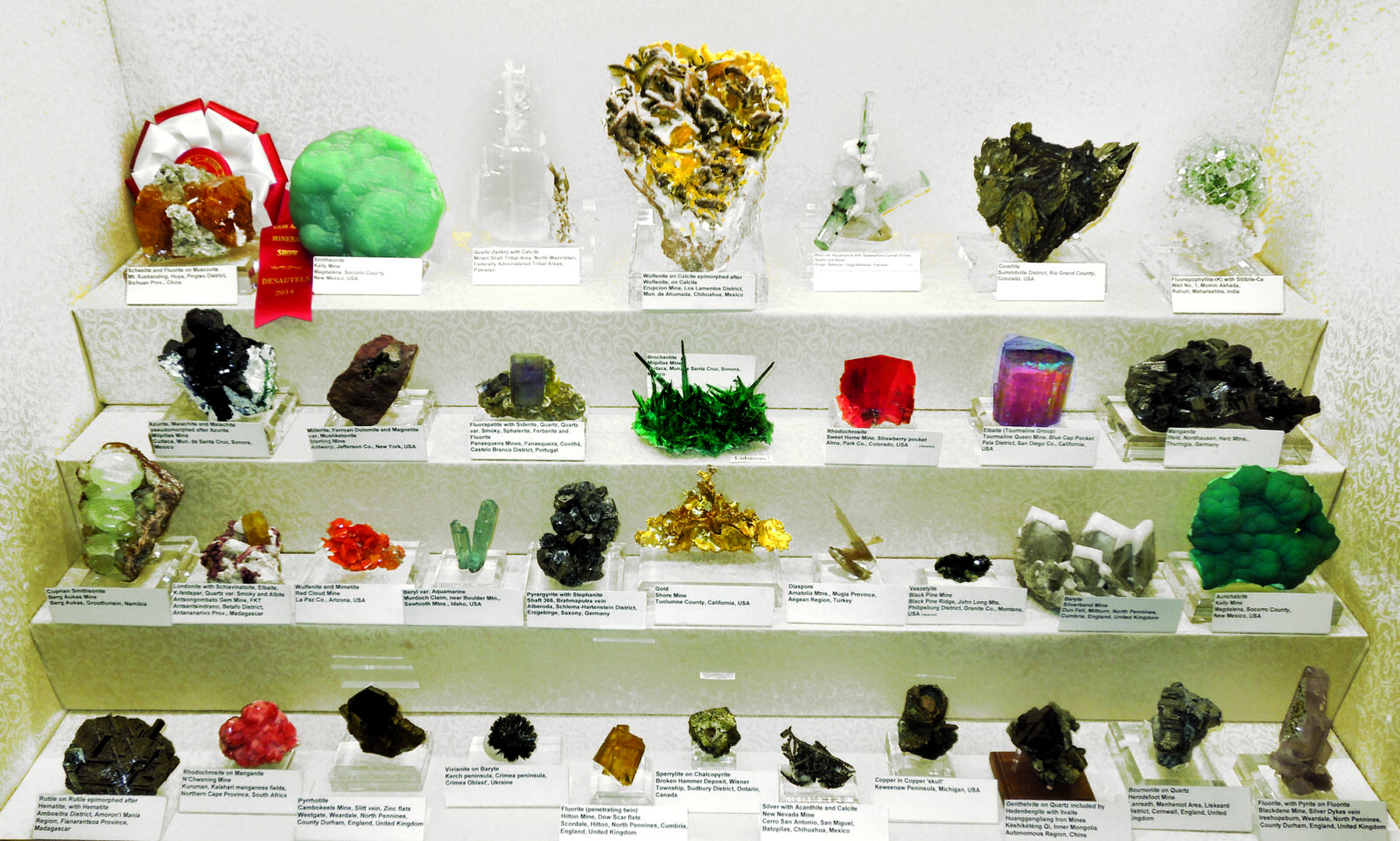
CONCLUSION
Whether you want to show off your specimens at the Tucson Show® or take it one step further and compete, the Show Committee heartily encourages you to bring your display. If in the process you can get your case evaluated in detail by highly knowledgeable and experienced collectors, does that not provide you with one more reason to display competitively? And what about the possibility of going home with a trophy and possibly one of the most prestigious trophies in the hobby, with either the Desautels or the Lidstrom (not taking anything away from the Denver Show because I (Les) am just as proud of our Pearl Trophies and their best-of-theme awards as our various Tucson Show® trophies)?
All of the information for competing at the Tucson Show® is available on the Tucson Gem and Mineral Show website. If there are any questions, feel free to contact Les Presmyk. See you at the next Tucson Show®!
MORE AWARD-WINNING CASES AND SPECIMENS
